(Also available in PDF)
Risk characterization integrates information and data acquired during the hazard identification, hazard characterization, and exposure assessment into an estimate of the adverse effects likely to occur in a given population. In this risk assessment, the risk characterization links the probability of exposure to Listeria monocytogenes from consumption of foods with the adverse health outcomes. The primary focus is on the prediction of the relative probability of contracting listeriosis from consumption of a single serving of food in one of the 23 food categories. Additional predictions also consider the extent of annual consumption of the various foods and the predicted contribution of each of the individual food categories to the number of listeriosis cases nationally.
This risk assessment is based on contaminated foods at the retail level. The risk characterization of the overall burden of listeriosis on public health includes both sporadic (i.e., illnesses not associated with a documented outbreak) and outbreak illnesses. Illnesses attributed to documented outbreaks are a small proportion of the total estimated annual cases of listeriosis. At this time it is not possible to separate the risk attributable to specific foods to sporadic and outbreak cases. Outbreaks frequently represent a breakdown in food production, manufacturing, or distribution systems instituted to prevent Listeria monocytogenes contamination. Assessing the likelihood that these systems will fail requires detailed information about the manufacture of individual foods that is beyond the scope of this assessment. However, an important benefit of conducting a risk assessment is the identification of knowledge and data gaps. Continuing research is needed to facilitate future Listeria monocytogenes risk assessment work (see Appendix 11: Reseach Needs).
The model is comprised of two major components--exposure and dose-response. These models are integrated for the risk characterization simulations as shown in Figure V-1.
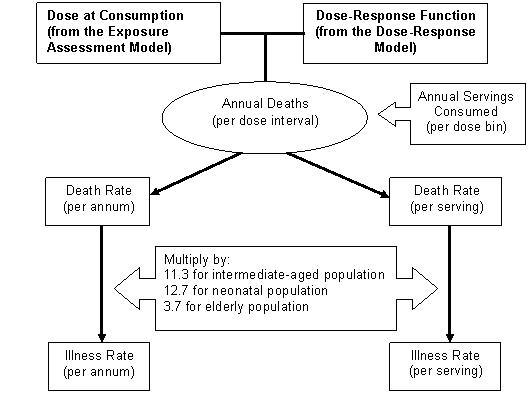
Figure V-1. Components of the Risk Characterization Model
A separate exposure simulation was constructed for each food category. Results from all the food categories were then carried forward to the dose-response simulations, where a separate simulation was constructed for each of the three subpopulation groups. Details of the various modeling steps are provided in Appendix 3.
The exposure assessment modeled the effect of various factors (e.g., frequency and extent of contamination at retail, consumption patterns, the growth potential of Listeria monocytogenes in foods, length of refrigerated storage, and refrigeration temperatures) that might affect levels of Listeria monocytogenes contamination in a food at the time of consumption. For the exposure assessment, a two-dimensional Monte-Carlo simulation (100,000 variability and 300 uncertainty iterations; total of 30,000,000 iterations) was used to integrate the components of the exposure model for each of the food categories. The result of each exposure simulation is the fraction of servings that occur at designated dose levels (broken out into half-log10 intervals), which are referred to as dose bins. The conversion to dose bins was necessary in order to integrate the exposure simulation, (which evaluated the exposure from individual servings) with the dose-response model (which predicted the number of cases at a population level). The exposure simulations produce 300 distributions (sets of dose bins) of predicted doses for each food category.
The dose-response simulation was carried out in several steps. First, the two-dimensional Monte-Carlo simulation (100,000 variability and 300 uncertainty iterations) was used to integrate the variability and uncertainty of the strain-virulence and host susceptibility functions for each of the subpopulations to provide dose-adjustment factors. The variability dimension for these combined dose-adjustment factors were then grouped into half-log10 bins, which ranged from -5 to +10 logs. Second, a one-dimensional (4,000 uncertainty iterations) dose-response simulation was run for each food category by selecting one of the 300 sets of dose bins from the exposure assessment.
These two sets of distributions (exposure dose bins for each food category and dose-response scaling factors for each subpopulation) consist of a relatively small set of finite values and were combined algebraically by adding the arrays. Although some resolution was lost through the creation of the bins for the distribution, avoidance of the use of random numbers provides greater precision at the tails of the summed distribution. In order to calculate the annual rates of cases of listeriosis, the number of deaths per year were multiplied by factors of 11.3 for intermediate-aged population, 12.7 for neonatal, and 3.7 for the elderly population. To calculate the number of perinatal deaths per year, the neonatal death estimate was multiplied by a factor of 2.5. The 2.5 is the approximate ratio of perinatal (106) to neonatal (41) deaths from the County of Los Angeles Department of Health Services (Buchholz, 2000).
The dose-response scaling factor was adjusted so that the sum of the dose-response function (derived from the mouse model) times the exposure assessment doses equaled the CDC estimates for the annual number of cases of listeriosis. This procedure anchors the overall predicted incidence of listeriosis with the actual incidence of listeriosis. An implicit assumption is that the foods encompassed by the 23 food categories account for all cases of foodborne listeriosis.
The medians of the 4,000 iterations of predicted deaths (per serving) for each food category and each subpopulation were reported. These predictions were ranked from highest to lowest. Because of the variability incorporated into the model (i.e., from differences in consumption of the foods in each categories, pathogen virulence, host susceptibility, and inherent uncertainty), the predicted relative ranking of food categories changes with each of the 4,000 iterations (in some cases significantly). To illustrate the degree of uncertainty associated with the relative risk ranking, the results of each set of the 4,000 iterations was ranked and compared. To this end, the ranking of each food category from 1st to 23rd was determined for each set of the 4,000 uncertainty iterations. The number of times each food category was observed to be ranked at each specific position was determined. These data were compiled and presented graphically (see the latitude graphs, Figures V-4a to V-26b in the section below titled "Summaries of the Food Categories").
For a more detailed explanation of two-dimensional Monte-Carlo and the dose-binning process, see Appendix 3.
The results of this risk assessment, the predicted relative risks of listeriosis associated with each food category, are presented first as an initial overview followed by a more detailed consideration of the individual food categories. The individual food category discussions further interpret the meaning and significance of the analyses in relation to the goal of the risk assessment, as well as discuss factors contributing to the variability and uncertainty associated with the predictions.
A significant difference between the FDA/FSIS risk assessment (the 2001 draft and this revised version) approach and prior attempts to evaluate the risks associated with ready-to-eat foods is the complexity of factors considered in the hazard characterization (Lindquist and Westöö, 2000, Buchanan et al., 1997; Farber et al., 1996; Haas et al., 1999; Hitchins, 1995 and 1996; and Teufel and Bendzulla, 1993). In addition to establishing a general dose-response relation, models were developed for three distinct age-based subpopulations and for assessing the full range of virulence potential that is likely to occur among Listeria monocytogenes isolates. It also emphasizes the fact that most exposures to Listeria monocytogenes seldom lead to listeriosis, even among highly susceptible segments of the population.
Medians (the value with 50% of the values above and 50% of the values below) are used to represent the "expected" (central tendency) of the estimated risk values. We used medians rather than means because the distributions have long "tails" (high uncertainty and skewed distributions). Medians are less influenced by these extreme values in the distribution but still allow us to represent the central tendency of the distribution with a single value. For other purposes, such as summing the food categories or additional calculations, the mean values are provided in Appendix 10.
Risk Per Serving
A key value used to assess the predicted relative risk among the 23 food categories is the "per serving" likelihood that consumption of a food will lead to listeriosis. This can be viewed as the risk that individual consumers face when they eat a serving of a food. The risk assessment results indicate that listeriosis could potentially be caused by foods in any of the food categories; that is, no food category is risk-free because almost any food could become contaminated with Listeria monocytogenes. It is equally apparent that there are substantial differences in risk among the different food categories.
As anticipated from the review of the scientific literature that was conducted in conjunction with this risk assessment, five factors have a large influence on the results of the exposure assessment and thus, the characterization of the predicted relative risk. These factors include the following.
Frequency and extent of Listeria monocytogenes in the food
Amounts and frequency of food consumption
Potential for growth of Listeria monocytogenes in food during refrigerated storage
Duration of refrigerated storage before consumption
Temperature at which the food was held during refrigerated storage
Any of these factors alone affects the potential contamination level at consumption. Those food categories in which one or more of these factors produce a greater risk of exposure to higher levels of Listeria monocytogenes contamination are more likely to increase consumers' risk of listeriosis. Examination of the food categories shows that certain factors may have a larger role in driving the predictions of higher risk. Food categories that contained foods that have a high growth potential, based on moderate or high growth rates, coupled with moderate or long storage times, were often the categories that had higher predicted relative risk values. These results have to be interpreted being cognizant of the fact that data on actual consumer storage practices were generally not available, so storage times were estimated based on expert judgment and USDA recommended practices. It is likely that the actual consumer storage times of food are longer than USDA recommendations.
As previously indicated in the description of the exposure assessment, other assumptions related to factors that could affect the frequency or extent of contamination could have a significant impact on the predicted relative risk per serving associated with individual food categories. These, in turn, could affect the predicted relative risk rankings of other food categories. For example, during manufacturing frankfurters are fully cooked to temperatures that are lethal for Listeria monocytogenes. However, subsequent recontamination prior to packaging may occur followed by growth of the pathogen. Although frankfurters are usually reheated prior to consumption, a portion of the population consumes them without reheating. To estimate the proportion of frankfurters consumed unreheated, a triangular distribution was used with a minimum of 4%, most likely of 7% and maximum of 10%. The impact of these types of assumptions on the predicted relative risk is considered in the discussion of the individual food categories.
Predicted Cases of Listeriosis per Serving. The results are summarized in Table V-1 as the median number of cases of listeriosis per serving for each of the three age-based subpopulations and the total United States population. Figure V-2 also shows the differential in median predicted risk per serving (the median values on a log scale are represented in the graph as a box) for the total United States population. The figure illustrates the point that elimination of Listeria monocytogenes from any single food will not eliminate foodborne listeriosis; control of listeriosis will require consideration of a variety of foods. However, some foods represent a substantially greater risk per serving and are likely to warrant additional attention from industry and regulators.
In addition to the median values, the 5th and 95th percentile values were also calculated for each of the subpopulations and the total United States population (Table V-1). These lower and upper bound values provide a method of estimating the uncertainty associated with the predictions. Figure V-2 shows these lower and upper bounds for the total United States population. In order to more easily present the data in a graph, the cases of listeriosis for each of the food categories is presented in Figure V-2 on a log scale. It is apparent that for some foods, the range covered was substantial. This was largely the result of exposure distributions where either a small percentage of the foods were predicted to have elevated levels of the pathogen or a high degree of uncertainty had to be assumed due to limitations in available data. The predicted relative risk values must be evaluated in relation to observed variability and uncertainty when using them to determine the best course of action for each of the different food categories. This interpretation of the results is discussed in greater depth for each of the individual food categories later in this chapter.
| Food Category | Number of Cases of Listeriosis per Servinga | ||||||||||||
|---|---|---|---|---|---|---|---|---|---|---|---|---|---|
| Intermediate-Age b | Elderly | Perinatalc | Total | ||||||||||
| Percentiles | Percentiles | Percentiles | Percentiles | ||||||||||
| Median | 5th | 95th | Median | 5th | 95th | Median | 5th | 95th | Median | 5th | 95th | ||
| SEAFOOD | Smoked Seafood | 2.1x10-9 | 8.8x10-11 | 1.2x10-7 | 1.9x10-8 | 9.7x10-10 | 1.0x10-6 | 8.4x10-7 | 4.3x10-8 | 4.6x10-5 | 6.2x10-9 | 3.0x10-10 | 3.3x10-7 |
| Raw Seafood | 1.3x10-11 | 1.1x10-17 | 2.9x10-10 | 1.3x10-10 | 1.7x10-14 | 2.9x10-9 | 6.7x10-9 | 7.4x10-12 | 2.0x10-7 | 2.0x10-11 | 7.4x10-15 | 4.6x10-10 | |
| Preserved Fish | 6.4x10-12 | 5.5x10-20 | 2.6x10-9 | 6.7x10-11 | 3.9x10-17 | 2.2x10-8 | 4.1x10-9 | 2.1x10-14 | 9.9x10-7 | 2.3x10-11 | 6.9x10-17 | 7.5x10-9 | |
| Cooked RTE Crustaceans | 2.2x10-9 | 2.5x10-10 | 2.1x10-8 | 1.9x10-8 | 2.4x10-9 | 1.6x10-7 | 7.4x10-7 | 9.7x10-8 | 6.1x10-6 | 5.1x10-9 | 6.5x10-10 | 4.6x10-8 | |
| PRODUCE | Vegetables | 8.4x10-13 | 1.5x10-19 | 6.3x10-11 | 8.2x10-12 | 3.7x10-16 | 5.7x10-10 | 4.8x10-10 | 1.4x10-13 | 3.1x10-8 | 2.8x10-12 | 2.8x10-16 | 1.9x10-10 |
| Fruits | 5.0x10-12 | 6.0x10-20 | 9.6x10-9 | 5.1x10-11 | 5.3x10-17 | 5.7x10-8 | 2.8x10-9 | 1.3x10-14 | 3.0x10-6 | 1.9x10-11 | 4.5x10-17 | 2.3x10-8 | |
| DAIRY | Fresh Soft Cheese | 1.2x10-10 | 4.6x10-13 | 2.1x10-9 | 1.0x10-9 | 5.0x10-12 | 1.7x10-8 | 4.2x10-8 | 2.6x10-10 | 7.0x10-7 | 1.7x10-10 | 8.0x10-13 | 2.9x10-9 |
| Soft Unripened Cheese | 5.8x10-10 | 8.4x10-14 | 1.6x10-8 | 4.9x10-9 | 7.2x10-13 | 1.2x10-7 | 2.0x10-7 | 4.8x10-11 | 5.3x10-6 | 1.8x10-9 | 2.8x10-13 | 4.4x10-8 | |
| Soft Ripened Cheese | 2.1x10-12 | 1.8x10-21 | 1.3x10-9 | 2.2x10-11 | 3.3x10-18 | 1.1x10-8 | 1.3x10-9 | 3.5x10-15 | 5.2x10-7 | 5.1x10-12 | 7.9x10-18 | 2.6x10-9 | |
| Semi-soft Cheese | 2.9x10-12 | 9.3x10-17 | 2.9x10-10 | 3.0x10-11 | 5.5x10-15 | 2.7x10-9 | 1.6x10-9 | 9.2x10-13 | 1.4x10-7 | 6.5x10-12 | 2.5x10-15 | 5.8x10-10 | |
| Hard Cheese | 3.4x10-15 | 5.3x10-47 | 1.9x10-12 | 9.2x10-15 | 5.8x10-39 | 1.9x10-11 | 8.1x10-13 | 3.4x10-32 | 1.3x10-9 | 4.5x10-15 | 2.5x10-35 | 5.5x10-12 | |
| Processed Cheese | 1.4x10-14 | 3.2x10-30 | 2.3x10-12 | 9.3x10-14 | 8.8x10-25 | 2.2x10-11 | 6.7x10-12 | 6.6x10-20 | 1.4x10-9 | 4.2x10-14 | 5.4x10-23 | 6.0x10-12 | |
| Pasteurized Fluid Milk | 4.4x10-10 | 2.8x10-11 | 5.7x10-9 | 3.4x10-9 | 2.5x10-10 | 3.9x10-8 | 1.5x10-7 | 1.2x10-8 | 1.7x10-6 | 1.0x10-9 | 7.5x10-11 | 1.3x10-8 | |
| Unpasteurized Fluid Milk | 2.9x10-9 | 3.5x10-11 | 6.8x10-8 | 2.2x10-8 | 3.4x10-10 | 5.1x10-7 | 9.9x10-7 | 1.7x10-8 | 2.3x10-5 | 7.1x10-9 | 9.7x10-11 | 1.6x10-7 | |
| Ice Cream/Frozen Dairy Products | 1.3x10-14 | 2.7x10-35 | 1.8x10-12 | 9.2x10-14 | 1.4x10-28 | 1.9x10-11 | 6.5x10-12 | 2.7x10-23 | 1.3x10-9 | 4.9x10-14 | 1.7x10-26 | 6.3x10-12 | |
| Cultured Milk Products | 9.5x10-15 | 2.4x10-40 | 1.7x10-11 | 5.6x10-14 | 6.5x10-33 | 1.7x10-10 | 4.7x10-12 | 5.1x10-26 | 9.9x10-9 | 3.2x10-14 | 3.3x10-29 | 4.9x10-11 | |
| High Fat and Other Dairy Products | 1.0x10-9 | 1.0x10-10 | 8.2x10-9 | 8.3x10-9 | 8.9x10-10 | 5.7x10-8 | 3.2x10-7 | 3.7x10-8 | 2.0x10-6 | 2.7x10-9 | 2.9x10-10 | 1.9x10-8 | |
| MEATS | Frankfurters (reheated) | 2.7x10-11 | 4.2x10-15 | 3.4x10-10 | 2.7x10-10 | 8.6x10-13 | 3.4x10-9 | 1.6x10-8 | 2.1x10-10 | 2.6x10-7 | 6.3x10-11 | 2.7x10-13 | 8.0x10-10 |
| Frankfurters (not reheated) | 3.3x10-8 | 3.1x10-9 | 2.8x10-7 | 2.9x10-7 | 3.2x10-8 | 2.3x10-6 | 1.1x10-5 | 1.3x10-6 | 8.3x10-5 | 6.5x10-8 | 7.1x10-9 | 5.2x10-7 | |
| Dry/Semi-Dry Fermented Sausages | 6.0x10-12 | 6.8x10-20 | 2.7x10-9 | 6.2x10-11 | 2.0x10-16 | 2.4x10-8 | 3.7x10-9 | 5.1x10-14 | 1.1x10-6 | 1.7x10-11 | 1.5x10-16 | 6.3x10-9 | |
| Deli Meats | 3.3x10-8 | 6.8x10-9 | 4.1x10-8 | 3.0x10-7 | 5.8x10-8 | 3.9x10-7 | 1.2x10-5 | 3.2x10-6 | 1.4x10-5 | 7.7x10-8 | 1.7x10-8 | 9.9x10-8 | |
| Pâté and Meat Spreads | 1.2x10-8 | 1.0x10-9 | 1.4x10-7 | 1.1x10-7 | 1.1x10-8 | 1.1x10-6 | 4.5x10-6 | 4.7x10-7 | 4.5x10-5 | 3.2x10-8 | 3.1x10-9 | 3.3x10-7 | |
| COMBINATION FOODS | Deli-type Salads | 1.7x10-13 | 1.8x10-31 | 1.3x10-10 | 1.4x10-12 | 3.3x10-25 | 1.2x10-9 | 8.8x10-11 | 9.3x10-20 | 5.5x10-8 | 5.6x10-13 | 8.0x10-23 | 4.1x10-10 |
| a This table provides estimates of the rate of listeriosis per serving and the confidence intervals about that estimate. For example, for the perinatal group in the Smoked Seafood category, the risk assessment estimates that there is only a 5% probability that the rate of listeriosis is less than 4.3 x 10-8 and a 95% probability that it is less than 4.6 x 10-5 (or a 5% probability that it is greater). The median risk estimate has a 50% probability of being greater or smaller than the rate of listeriosis. b The Intermediate-age population includes susceptible populations not captured in the other groups, such as cancer, AIDS, and transplant patients, for whom there are insufficient data to consider as a separate population. cThe Perinatal population is a susceptible population that includes fetuses and neonates. Exposure occurs in utero from contaminated food eaten by the pregnant woman. The predicted cases are predominately neonatal, therefore to estimate the perinatal cases presented in this table, an exposure period of 10 days was used. The value of 10 approximately corresponds to the mean of the triangle distribution (1, 7, 30) used in the simulation. | |||||||||||||
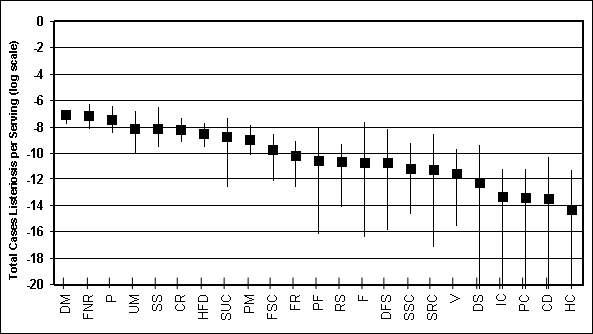
Figure V-2. Predicted Cases of Listeriosis (log scale) Associated with Food Categories
for the Total United States Population on a per Serving Basis
[The box indicates the median predicted number of cases of listeriosis (log scale) and the bar indicates the lower and upper bounds (i.e., the 5th and 95th percentiles). The y-axis values are presented on a log scale. For example a log of -6 is equivalent to 1 in a million.]
DM = Deli meats; FNR = Frankfurters (not reheated); P= Pâté and Meat Spreads; UM= Unpasteurized Fluid Milk; SS= Smoked Seafood; CR = Cooked Ready-To-Eat Crustaceans; HFD = High Fat and Other Dairy Products; SUC = Soft Unripened Cheese; PM = Pasteurized Fluid Milk; FSC = Fresh Soft Cheese; FR = Frankfurters (reheated); PF = Preserved Fish; RS = Raw Seafood; F = Fruits; DFS= Dry/Semi-dry Fermented Sausages; SSC = Semi-soft Cheese; SRC = Soft Ripened Cheese; V = Vegetables; DS = Deli-type Salads; IC= Ice Cream and Frozen Dairy Products; PC = Processed Cheese; CD = Cultured Milk Products; HC = Hard Cheese.
Predicted Risk Ranking. The predicted median values for the cases of listeriosis on a per serving basis were used to develop predicted relative risk ranks. The median predicted relative risk ranking among the different food categories is summarized for the three subpopulations and the total United States population in Table V-2. It is apparent that the predicted relative risk rankings of the food categories are similar for the three subpopulations, but not identical.
The uncertainty associated with the risk ranking is described in the latitude ranking graphs that are presented as part of the discussion of each of the individual food categories (see Figures V-4a to V-26b). It is important to note that in a number of instances there are only minor differences separating the rankings of various food categories.
Although the number of iterations in the ranking process was very high (4,000), analysis of variance techniques were used to provide an indication of the statistical certainty of the rankings. Nonparametric analysis of variance technique (i.e. Kruskal-Wallis Test), followed by a multiple comparison procedure, was used to evaluate the differences in the median rankings of risk per serving for the total United States population. The analyses were performed using NCSS (NCSS, 2001) to determine which of the median rankings were not significantly different based on the number of simulation samples (iterations) and an alpha level of 0.05 for the family-wide error rate with respect to all pairwise comparisons of the 23 food categories. The results are shown in Table V-2.
| Food Categoriesa | Subpopulation | ||||
|---|---|---|---|---|---|
| Intermediate Ageb | Elderlyb | Perinatalb | Total b, c | ||
| SEAFOOD | Smoked Seafood | 6 | 5 | 5 | 5b |
| Raw Seafood | 12 | 12 | 12 | 13d | |
| Preserved Fish | 13 | 13 | 13 | 12d,e | |
| Cooked Ready-to-Eat Crustaceans | 5 | 6 | 6 | 6b | |
| PRODUCE | Vegetables | 18 | 18 | 18 | 18 |
| Fruits | 15 | 15 | 15 | 14e | |
| DAIRY | Fresh Soft Cheese | 10 | 10 | 10 | 10 |
| Soft Unripened Cheese, >50% moisture | 8 | 8 | 8 | 8c | |
| Soft Ripened Cheese, >50% moisture | 17 | 17 | 17 | 17f | |
| Semi-soft Cheese, 39-50% moisture | 16 | 16 | 16 | 16f | |
| Hard Cheese, <39% moisture | 23 | 23 | 23 | 23 | |
| Processed Cheese | 20 | 20 | 20 | 21g | |
| Pasteurized Fluid Milk | 9 | 9 | 9 | 9c | |
| Unpasteurized Fluid Milk | 4 | 4 | 4 | 4b | |
| Ice Cream and Frozen Dairy Products | 21 | 21 | 21 | 20g | |
| Cultured Milk Products | 22 | 22 | 22 | 22g | |
| High Fat and Other Dairy Products | 7 | 7 | 7 | 7 | |
| MEATS | Frankfurters, reheated | 11 | 11 | 11 | 11 |
| Frankfurters, not reheated | 2 | 2 | 2 | 2a | |
| Dry/Semi-Dry Fermented Sausages | 14 | 14 | 14 | 15d | |
| Deli Meats | 1 | 1 | 1 | 1a | |
| Pâté and Meat Spreads | 3 | 3 | 3 | 3 | |
| COMBINATION FOODS | Deli-type Salads | 19 | 19 | 19 | 19 |
| a Food categories are grouped by type of food but are not in any particular order. b A ranking of 1 indicates the food category with the greatest predicted relative risk per serving of causing listeriosis and a ranking of 23 indicates the lowest predicted relative risk of causing listeriosis. c Ranks with the same letter are not significantly different based on the Bonferroni Multiple Comparison Test (alpha = 0.05). | |||||
Risk per Annum
A full picture of listeriosis risk requires consideration of the number of servings consumed, as well as the risk per serving. These data were considered for each of the food categories and used to calculate the predicted cases of listeriosis on a per annum basis. If the "risk per serving" is considered the predicted relative risk faced by each consumer, then the "risk per annum" is a measure of the predicted relative risk faced by the country. The risk per annum is greatly affected by the number of servings per year. Thus, a food that has a relatively high risk on a per serving basis but is seldom consumed may have a relatively low per annum risk. Conversely, a food with a relatively low risk on a per serving basis that is consumed extensively is likely to have a higher risk on a per annum basis. Table III-2 shows the wide range in number of annual servings among the food categories. The per annum relative risks inherently have a greater degree of uncertainty than the corresponding per serving relative risk because of the additional uncertainty associated with the number of annual servings. Another factor that affects predicted relative risk on a per annum basis is the size of the subpopulations, in proportion to the total population. They are substantially different, i.e., perinatal, elderly, and intermediate-age groups, represent approximately 2%, 13%, and 85% of the total population, respectively.
The results were generated in a manner similar to that described above for the predicted relative risk per serving. Table V-3 provides the predicted median number of cases of listeriosis on a per annum basis for each of the age-based populations. The upper and lower bounds (5th and 95th percentile values) are also provided in Table V-3 to show the range of variability and uncertainty of the estimates. The range in the predicted number of cases of listeriosis is depicted in Figure V-3 for the total United States population.
The predicted relative risk ranking is presented in Table V-4. The uncertainty associated with the ranking is also described using individual latitude ranking graphs based on the rankings for the total United States population (see Figures V-4a to V-26b). These graphs are provided in the discussions of individual food categories. It is important to note that the differences among several of the food categories were very small, so differences between adjacent or closely occurring ranks must only be considered in conjunction with the estimates of uncertainty which are provided as part of the discussion of the individual food categories.
In most instances, the food categories that had high predicted relative risk rankings on a per serving basis also had a high predicted relative risk ranking on a per annum basis. However, there were instances where foods with lower risk per serving rankings had higher risk per annum values and vice versa. For example, Pâté and Meat Spreads had a higher predicted relative risk on a per serving basis than on a per annum basis. This reflects the fact that foods in this category are eaten relatively infrequently and in relatively small amounts. Conversely, Vegetables and Pasteurized Fluid Milk are products where a predicted low or moderate per serving relative risk was elevated on a per annum basis. In these examples, this appears to be a function of two factors. The first is the variability in the data sets available on a worldwide basis (see discussion of individual foods in the section titled "Overview and Discussion of Food Categories"). A wide degree of variability increases the number of predicted exposure values in the "tails" of the distribution. To a large extent, it is these extremes of the distributions that determine the per annum risk. The second is that the numbers of servings consumed annually for Vegetables and Pasteurized Fluid Milk are several orders of magnitude higher than other food categories. Again, this strongly influences the per annum predicted relative ranking for these foods. With both of these food categories, the results of the risk assessment must be interpreted in relation to the uncertainty estimates. The best interpretation may be the need to assure continued vigilance. However, these data do demonstrate how a risk assessment can provide a means of systematically examining risks from different vantage points. The results clearly point out that a relatively low predicted relative risk per serving associated with foods that are consumed extensively (such as Pasteurized Fluid Milk or Vegetables) could lead to a potentially greater impact on the relative risk of listeriosis per annum.
| Food Category | Number of Cases of Listeriosis per Annuma | ||||||||||||
|---|---|---|---|---|---|---|---|---|---|---|---|---|---|
| Intermediate-Age b | Elderly | Perinatal c | Total | ||||||||||
| Percentiles | Percentiles | Percentiles | Percentiles | ||||||||||
| Median | 5th | 95th | Median | 5th | 95th | Median | 5th | 95th | Median | 5th | 95th | ||
| SEAFOOD | Smoked Seafood | 0.3 | <0.1 | 19.4 | 0.8 | <0.1 | 43.2 | 0.1 | <0.1 | 5.8 | 1.3 | 0.1 | 68.1 |
| Raw Seafood | <0.1 | <0.1 | 0.1 | <0.1 | <0.1 | <0.1 | <0.1 | <0.1 | <0.1 | <0.1 | <0.1 | 0.1 | |
| Preserved Fish | <0.1 | <0.1 | 0.2 | <0.1 | <0.1 | 0.5 | <0.1 | <0.1 | 0.1 | <0.1 | <0.1 | 0.8 | |
| Cooked Ready-to-Eat Crustaceans | 1.0 | 0.1 | 10.0 | 1.5 | 0.2 | 13.2 | 0.3 | <0.1 | 2.2 | 2.8 | 0.4 | 25.7 | |
| PRODUCE | Vegetables | 0.1 | <0.1 | 4.3 | 0.1 | <0.1 | 9.7 | <0.1 | <0.1 | 1.6 | 0.2 | <0.1 | 15.7 |
| Fruits | 0.2 | <0.1 | 351.4 | 0.6 | <0.1 | 680.4 | 0.1 | <0.1 | 85.4 | 0.9 | <0.1 | 1127.7 | |
| DAIRY | Fresh Soft Cheese | <0.1 | <0.1 | 0.1 | <0.1 | <0.1 | <0.1 | <0.1 | <0.1 | <0.1 | <0.1 | <0.1 | 0.2 |
| Soft Unripened Cheese | 2.0 | <0.1 | 52.3 | 5.1 | <0.1 | 128.8 | 0.5 | <0.1 | 13.6 | 7.7 | <0.1 | 193.5 | |
| Soft Ripened Cheese | <0.1 | <0.1 | 2.1 | <0.1 | <0.1 | 2.1 | <0.1 | <0.1 | 0.7 | <0.1 | <0.1 | 4.9 | |
| Semi-soft Cheese | <0.1 | <0.1 | 0.5 | <0.1 | <0.1 | 0.4 | <0.1 | <0.1 | 0.2 | <0.1 | <0.1 | 1.1 | |
| Hard Cheese | <0.1 | <0.1 | <0.1 | <0.1 | <0.1 | <0.1 | <0.1 | <0.1 | <0.1 | <0.1 | <0.1 | <0.1 | |
| Processed Cheese | <0.1 | <0.1 | <0.1 | <0.1 | <0.1 | <0.1 | <0.1 | <0.1 | <0.1 | <0.1 | <0.1 | 0.1 | |
| Pasteurized Fluid Milk | 31.4 | 2.0 | 410.1 | 49.8 | 3.7 | 584.4 | 8.0 | 0.7 | 95.8 | 90.8 | 6.5 | 1084.6 | |
| Unpasteurized Fluid Milk | 1.1 | <0.1 | 24.7 | 1.7 | <0.1 | 38.3 | 0.3 | <0.1 | 6.5 | 3.1 | <0.1 | 69.2 | |
| Ice Cream/Frozen Dairy Products | <0.1 | <0.1 | <0.1 | <0.1 | <0.1 | 0.1 | 0.0 | <0.1 | <0.1 | <0.1 | <0.1 | 0.1 | |
| Cultured Milk Products | <0.1 | <0.1 | 0.1 | <0.1 | <0.1 | 0.2 | 0.0 | <0.1 | <0.1 | <0.1 | <0.1 | 0.4 | |
| High Fat and Other Dairy Products | 17.0 | 1.7 | 135.0 | 35.1 | 3.8 | 241.3 | 4.0 | 0.5 | 25.3 | 56.4 | 6.0 | 398.9 | |
| MEATS | Frankfurters (reheated) | 0.1 | <0.1 | 1.9 | 0.2 | <0.1 | 2.0 | 0.1 | <0.1 | 1.1 | 0.4 | <0.1 | 4.9 |
| Frankfurters (not reheated) | 13.8 | 1.3 | 119.4 | 13.0 | 1.4 | 103.0 | 3.6 | 0.4 | 26.9 | 30.5 | 3.3 | 245.4 | |
| Dry/Semi-Dry Fermented Sausages | <0.1 | <0.1 | 4.1 | <0.1 | <0.1 | 6.0 | <0.1 | <0.1 | 1.3 | <0.1 | <0.1 | 11.2 | |
| Deli Meats | 589.1 | 120.6 | 736.4 | 849.6 | 164.6 | 1106.2 | 161.2 | 44.5 | 197.0 | 1598.7 | 341.2 | 2038.2 | |
| Pâté and Meat Spreads | 1.2 | 0.1 | 13.2 | 2.2 | 0.2 | 23.5 | 0.3 | <0.1 | 3.4 | 3.7 | 0.4 | 39.5 | |
| COMBINATION FOODS | Deli-type Salads | <0.1 | <0.1 | 1.3 | <0.1 | <0.1 | 3.8 | <0.1 | <0.1 | 0.4 | <0.1 | <0.1 | 5.4 |
| a This table provides estimates of the rate of listeriosis per annum and the confidence intervals about that estimate. b The Intermediate-age group includes susceptible populations not captured in other groups, such as cancer, AIDS, and transplant patients, for whom there are insufficient data to consider as a separate population. c The Perinatal population is a susceptible population that includes fetuses and neonates. Exposure occurs most often in utero from contaminated food eaten by the pregnant woman. | |||||||||||||
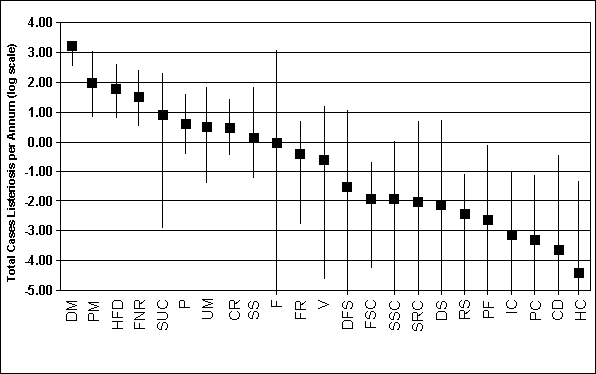
Figure V-3. Predicted Cases of Listeriosis (log scale) Associated with Food Categories
for the Total United States Population on a per Annum Basis
[The box indicates the median predicted number of cases of listeriosis (log scale) and the bar indicates the lower and upper bounds (i.e., the 5th and 95th percentiles. The y-axis values are presented on a log scale. For example a log of -3 is equivalent to 1 in a thousand.]
DM = Deli meats; PM = Pasteurized Fluid Milk; HFD = High Fat and Other Dairy Products; FNR = Frankfurters (not reheated); SUC = Soft Unripened Cheese; P= Pâté and Meat Spreads; CR = Cooked Ready-To-Eat Crustaceans; UM= Unpasteurized Fluid Milk; SS= Smoked Seafood; F = Fruits; FR = Frankfurters (reheated); V = Vegetables; DFS= Dry/Semi-dry Fermented Sausages; FSC = Fresh Soft Cheese; SSC = Semi-soft Cheese; SRC = Soft Ripened Cheese; DS = Deli-type Salads; RS = Raw Seafood; PF = Preserved Fish; IC= Ice Cream and Frozen Dairy Products; PC = Processed Cheese; CD = Cultured Milk Products; HC = Hard Cheese.
| Food Categoriesa | Subpopulation | ||||
|---|---|---|---|---|---|
| Intermediate Ageb | Elderlyb | Perinatalb | Total b, c | ||
| SEAFOOD | Smoked Seafood | 9 | 9 | 9 | 9 |
| Raw Seafood | 17 | 21 | 17 | 18g | |
| Preserved Fish | 19 | 17 | 19 | 19g | |
| Cooked Ready-to-Eat Crustaceans | 8 | 8 | 8 | 8b,d,e | |
| PRODUCE | Vegetables | 12 | 12 | 12 | 12 |
| Fruits | 10 | 10 | 10 | 10 | |
| DAIRY | Fresh Soft Cheese | 14 | 18 | 14 | 14f |
| Soft Unripened Cheese, >50% moisture | 5 | 5 | 5 | 5b,c | |
| Soft Ripened Cheese, >50% moisture | 16 | 16 | 16 | 16f | |
| Semi-soft Cheese, 39-50% moisture | 15 | 15 | 15 | 15f | |
| Hard Cheese, <39% moisture | 23 | 23 | 23 | 23 | |
| Processed Cheese | 20 | 20 | 21 | 21h | |
| Pasteurized Fluid Milk | 2 | 2 | 2 | 2a | |
| Unpasteurized Fluid Milk | 7 | 7 | 7 | 7d,e | |
| Ice Cream and Frozen Dairy Products | 21 | 19 | 20 | 20h | |
| Cultured Milk Products | 22 | 22 | 22 | 22h | |
| High Fat and Other Dairy Products | 3 | 3 | 3 | 3a | |
| MEATS | Frankfurters, reheated | 11 | 11 | 11 | 11 |
| Frankfurters, not reheated | 4 | 4 | 4 | 4 | |
| Dry/Semi-Dry Fermented Sausages | 13 | 13 | 13 | 13 | |
| Deli Meats | 1 | 1 | 1 | 1 | |
| Pâté and Meat Spreads | 6 | 6 | 6 | 6b,c,d | |
| COMBINATION FOODS | Deli-type Salads | 18 | 14 | 18 | 17f |
| a Food categories are grouped by type of food but are not in any particular order. b A ranking of 1 indicates the food category with the greatest predicted relative risk of causing listeriosis and a ranking of 23 indicates the lowest predicted relative risk of causing listeriosis. c Ranks with the same letter are not significantly different based on the Bonferroni Multiple Comparison Test (alpha=0.05). | |||||
Because Listeria monocytogenes is ubiquitous in foods and the food-processing environment, a large number of foods needed to be considered in this risk assessment. In order to have a practicable number of food groupings, 23 categories were formed from the more than 640 ready-to-eat foods in the consumption surveys. These categories are sometimes broadly defined to include several distinct but similar classes of food, while in other instances they are quite small and specific. The foods included in this risk assessment are primarily organized into categories based on primary origin of the foods (e.g., seafood, vegetable, dairy, meat), composition and processing (moisture content, raw vs. cooked, pH, salt level), contamination with Listeria monocytogenes, and association with listeriosis. Although generally similar, some characteristics of foods within a single category may vary. For example, within a single food category, consumption may be greater for one food, contamination higher in another, and average rate of growth in a third food. In the future, if further investigations of an individual food category or a particular food within a category are conducted, the model developed in the current risk assessment could be modified to provide a more detailed analysis.
Consumption estimates on a per serving basis were determined, as well as the amount of food eaten per person per day. Data indicate that, for the one or two days of the consumption surveys, there were 1.8 x 109 servings consumed of the foods identified in the 23 categories. Extrapolated to an annual basis, there were 3.4 x 1011 servings consumed in a year. The vast majority (96.3% or 2.5 x 108 individuals) of the population reported eating the foods included in this risk assessment. There were a relatively low number of eaters for some of the food categories (e.g., Smoked Seafood, Fresh Soft Cheese, Pâté and Meat Spreads), while other food categories are consumed widely and often (e.g., Pasteurized Milk, Vegetables). Consumption information for each food category is included in the discussion below.
Contamination levels at retail ranged from less than 0.04 cfu/g to more than 106 cfu/g in the food data considered in this analysis. The highest levels reported for specifically identified food products were in the range of 105 to 106 cfu/g, although the results of laboratory investigations indicate that contamination levels greater than 106 cfu/g can occur. Studies that were limited to the determination of presence or absence were assigned a contamination value commensurate with the lowest limit of detection possible: 0.04 cfu/g. The highest frequency of contaminated samples was 12.9 % (Smoked Seafood). All food categories demonstrated some contamination, with a range of positive samples from 0.2 % to 12.9 % (see Table III-4). The frequency of occurrence of contaminated samples was lower at higher contamination levels. The contamination studies used in this study were published over a period of seventeen years (1985-2002). Because there was a major effort worldwide to control foodborne listeriosis, the incidence of contamination was evaluated for differences in data published pre-1993, 1993 to 1998, and post-1998. To estimate the current variation in contamination, studies were weighted by number of samples, country, and date of publication as explained in Chapter III: Exposure Assessment. Food categories with no recent data were adjusted by a factor relative to the other food categories.
To predict possible growth between retail sampling and consumption, a growth model was created, based on growth rates from studies of various foods inoculated with Listeria monocytogenes under laboratory conditions. These studies were conducted at a number of temperatures. The reported growth rates were adjusted to give the equivalent growth rate at 5°C. Within each food category, the adjusted Exponential Growth Rate (EGR) from individual studies was used to develop a distribution of growth rate values. As previously mentioned, little data were available that adequately described the distribution of storage times (except for frankfurters and deli meats). Therefore, a modified BetaPert distribution was created for each food category, with minimum, most likely and maximum times (days) to account for the variation in storage times. The minimum time for all food categories (0.5 day) represents food consumed within 24 hours of purchase. For each specific food category, the most likely and maximum values were given an uncertainty range. For frankfurters and deli meats, an empirical data set was used (AMI, 2001). For each iteration of the growth simulation, the model selected a refrigeration storage temperature (that varied from 1 to 11°C) and calculated the EGR (log10 cfu/day) at that temperature. The EGR was multiplied by the storage time to estimate growth from retail to consumption and the estimated growth was added to the initial number of Listeria monocytogenes to calculate the total Listeria monocytogenes. The projected growth was limited by temperature-dependent maximum growth values (stationary phase). The maximum growth was greater at higher storage temperatures than at lower temperatures. In addition, the model contained a negative correlation between storage temperature and storage times. This minimized combinations of long storage times and high temperatures that would most likely result in detectable spoilage from other microorganisms and disposal of the food rather than consumption.
Because the risk assessment model is based on many parameters and an extensive amount of both qualitative and quantitative data, it can be difficult to determine the impact of each of the factors considered. Accordingly, sets of qualitative descriptors were developed to aid in the discussion and comparison of these parameters in the food categories. The criteria used to characterize data among food categories as low/moderate/high or short/moderate/long for each parameter are presented in Table V-5a. Table V-5b provides a characterization of each of the parameters for each food category. See Appendices 5, 7 and 8 for the supporting data.
An overview of each of the 23 food categories is provided in this chapter including information for each food category on cases of listeriosis, consumption, contamination, and growth of Listeria monocytogenes, and a summary of the designated parameter levels based on the criteria listed in Table V-5a. In addition, the latitude graphs (Figures V-4a to V-26b) show the uncertainty associated with the predicted relative risk rankings on both a per serving and per annum basis for each food category. These graphs show how frequently a food category ranked 1st, 2nd , and so on to 23rd. A food category that primarily ranked 1st or 2nd should be considered a higher risk than a food category that primarily ranked 22nd or 23rd. The distribution of rankings shown for a food category is an indication of the certainty of its ranking. The narrower the range, the greater is the certainty associated with the relative risk ranking.
As an initial means of categorizing the results of the risk assessment in order to relate them to the characteristics of the different food categories, the relative predicted risk on a per serving basis was classified as high, moderate, or low. The following criteria was used: high = >5 predicted cases of listeriosis per billion servings; moderate = <5 but ![]() 1 predicted case per billion servings, and low = <1 predicted case per billion servings. Based on these criteria, five of the foods were considered to be high risk, four were in the moderate risk group, and the remaining foods fell into the low risk per serving category (Table V-6). The number of predicted cases per annum in the United States for the total population was classified as low (less than 1 case per annum), moderate (>1 to 10 cases per annum), high (>10 to 100 cases), and very high (>100 cases). Based on these criteria, one food category was considered very high, three food categories were considered to cause a high number of cases and five food categories a moderate number of cases, with the remaining considered low. Additional means of grouping the results are considered later in the document (see the cluster analysis in Chapter VII).
1 predicted case per billion servings, and low = <1 predicted case per billion servings. Based on these criteria, five of the foods were considered to be high risk, four were in the moderate risk group, and the remaining foods fell into the low risk per serving category (Table V-6). The number of predicted cases per annum in the United States for the total population was classified as low (less than 1 case per annum), moderate (>1 to 10 cases per annum), high (>10 to 100 cases), and very high (>100 cases). Based on these criteria, one food category was considered very high, three food categories were considered to cause a high number of cases and five food categories a moderate number of cases, with the remaining considered low. Additional means of grouping the results are considered later in the document (see the cluster analysis in Chapter VII).
| Parameter | Designated Parameter Level | ||
|---|---|---|---|
| Low/Short | Moderate | High/Long | |
| Number of Annual Servings | > 1x109 to < 1 x 1010 | ||
| Median Amount Consumed per Serving (g) | > 40 g to < 90 g | ||
| Contamination Frequency (%) | > 2% to < 5% | ||
| Contamination at Retail--Predicted Servings at 103 to 106 cfu (%) | >0.1% to < 0.6% | ||
| Exponential Growth Rate at 5 °C (log10 cfu/day) | > 0.1 to < 0.2 | ||
| Most Likely Storage Time (days) | > 2 to 5 days | ||
| Food Category | Number of Annual Servings |
Median Amount Consumed |
Contamination Frequency |
Contamination Level at Retail |
Growth Rate During Storage |
Storage Time |
|
|---|---|---|---|---|---|---|---|
| SEAFOOD | Smoked Seafood | Low | Moderate | High | High | Moderate | Moderate |
| Raw Seafood | Low | Low | High | High | Moderate | Short | |
| Preserved Fish | Low | Moderate | High | Moderate | --a | --a | |
| Cooked Ready-to-Eat Crustaceans | Low | Moderate | Moderate | Moderate | High | Short | |
| PRODUCE | Vegetables | High | Low | Moderate | Low | Low | Moderate |
| Fruits | High | High | High | Low | Low | Moderate | |
| DAIRY | Fresh soft cheese | Low | Low | Low | Low | Low | Moderate |
| Soft Unripened Cheese >50% moisture | Moderate | Low | Moderate | Moderate | Lowb | Long | |
| Soft Ripened Cheese >50% moisture | Moderate | Low | Moderate | Low | Lowb | Long | |
| Semi-soft cheese 39-50% moisture | Moderate | Low | Moderate | Low | Lowb | Long | |
| Hard Cheese <39% moisture | Moderate | Low | Low | Low | Lowb | Long | |
| Processed Cheese | High | Low | Low | Low | Lowb | Long | |
| Pasteurized Fluid Milk | High | High | Low | Low | High | Moderate | |
| Unpasteurized Fluid Milk | Low | High | Moderate | Moderate | High | Moderate | |
| Ice Cream and Frozen Dairy Products | High | High | Low | Low | --a | --a | |
| Cultured Milk Products | Moderate | High | Low | Low | Lowb | Long | |
| High Fat and Other Dairy Products | High | Low | Low | Low | Moderate | Long | |
| MEATS | Frankfurters, reheated | Moderate | Moderate | Moderate | High | Moderate | Moderate |
| Frankfurters, not reheated | Low | Moderate | Moderate | High | Moderate | Moderate | |
| Dry/Semi-Dry Fermented Sausages | Moderate | Moderate | High | Moderate | Lowb | Long | |
| Deli Meats | High | Moderate | Moderate | High | High | Long | |
| Pâté and Meat Spreads | Low | Moderate | High | Moderate | High | Long | |
| COMBINATION FOODS | Deli-type Salads | High | High | Moderate | Low | Lowc | Moderate |
| a A non-growth food category; growth rates and storage times are not applicable. b Includes probabilities that Listeria monocytogenes numbers will decline during storage. cOverall Listeria monocytogenes declines in deli salads but it can grow at a moderate rate in a small fraction of salads. | |||||||
| Relative Risk Ranking | Predicted Median Cases of Listeriosis for 23 Food Categories | |||||
|---|---|---|---|---|---|---|
| Per Serving Basisa | Per Annum Basisb | |||||
| Food | Cases | Food | Cases | |||
| 1 |
High |
Deli Meats |
7.7x10-8 |
Very |
Deli Meats | 1598.7 |
| 2 | Frankfurters, not reheated |
6.5x10-8 |
High |
Pasteurized Fluid Milk |
90.8 | |
| 3 | Pâté and Meat Spreads |
3.2x10-8 | High Fat and Other Dairy Products |
56.4 | ||
| 4 | Unpasteurized Fluid Milk |
7.1x10-9 |
Frankfurters, not reheated |
30.5 | ||
| 5 | Smoked Seafood |
6.2x10-9 |
Moderate |
Soft Unripened Cheese |
7.7 | |
| 6 | Cooked Ready-to-Eat Crustaceans |
5.1x10-9 | Pâté and Meat Spreads |
3.8 | ||
| 7 |
Moderate |
High Fat and Other Dairy Products |
2.7x10-9 | Unpasteurized Fluid Milk |
3.1 | |
| 8 | Soft Unripened Cheese |
1.8x10-9 | Cooked Ready-to-Eat Crustaceans |
2.8 | ||
| 9 | Pasteurized Fluid Milk |
1.0x10-9 | Smoked Seafood |
1.3 | ||
| 10 |
Low |
Fresh Soft Cheese |
1.7x10-10 |
Low |
Fruits |
0.9 |
| 11 | Frankfurters, reheated |
6.3x10-11 |
Frankfurters, reheated |
0.4 | ||
| 12 | Preserved Fish |
2.3x10-11 | Vegetables |
0.2 | ||
| 13 | Raw Seafood |
2.0x10-11 | Dry/Semi-dry Fermented Sausages |
<0.1 | ||
| 14 | Fruits |
1.9x10-11 | Fresh Soft Cheese |
<0.1 | ||
| 15 | Dry/Semi-dry Fermented Sausages |
1.7x10-11 | Semi-Soft Cheese |
<0.1 | ||
| 16 | Semi-soft Cheese |
6.5x10-12 | Soft Ripened Cheese |
<0.1 | ||
| 17 | Soft Ripened Cheese |
5.1x10-12 | Deli-type Salads |
<0.1 | ||
| 18 | Vegetables |
2.8x10-12 | Raw Seafood |
<0.1 | ||
| 19 | Deli-type Salads |
5.6x10-13 | Preserved Fish |
<0.1 | ||
| 20 | Ice Cream and Other Frozen Dairy Products |
4.9x10-14 | Ice Cream and Other Frozen Dairy Products |
<0.1 | ||
| 21 | Processed Cheese |
4.2x10-14 | Processed Cheese |
<0.1 | ||
| 22 | Cultured Milk Products |
3.2x10-14 | Cultured Milk Products |
<0.1 | ||
| 23 | Hard Cheese |
4.5x10-15 | Hard Cheese |
<0.1 | ||
|
a Food categories were classified as high risk (>5 cases per billion servings), moderate risk ( | ||||||
The foods in the Smoked Seafood category had a high predicted relative risk of causing listeriosis on a per serving basis. This reflects the fact that Smoked Seafood has a high frequency of contamination; high levels of contamination at retail, supports a moderate rate of growth; and is often stored for moderate lengths of time (and occasionally long periods of time). This is offset somewhat by the moderate serving sizes and the low number of servings associated with this food category. These combine to make Smoked Seafood a moderate contributor to the total number of predicted cases of listeriosis per year.
The predicted relative risk per serving for Smoked Seafood is consistent with various smoked seafoods having been associated with listeriosis. Smoked mussels have been linked to outbreaks of listeriosis in Australia and New Zealand, cold smoked rainbow trout to an outbreak in Sweden, smoked salmon to sporadic cases in Australia, and smoked cod roe to sporadic cases in Denmark (Ryser, 1999a; Brett et al., 1998; Ericsson et al., 1997). Contaminated retail packages are regularly identified by regulatory surveillance programs (Ryser and Marth, 1999a). However, the small volume of most production lots and a low number of servings consumed means that outbreaks are unlikely from a contaminated product; sporadic cases would be expected to be the typical consequences of Listeria monocytogenes in this food category.
Foods included in this category from the consumption databases are smoked salmon, trout, herring, oysters, and other smoked fish not identified as to species. Both hot and cold smoked products are included in this category, in part because the consumption databases do not distinguish between these two processes. The predicted median amount consumed per serving for this category is 57.0 g (approximately 2 ounces), and the annual total number of servings in the United States is only 2.0x108 (i.e., less than 1 serving per person per annum, on average).
Data from 30 smoked seafood studies provided the contamination data used for this category. Only six of these studies were conducted in the United States. Quantitative data were available in 10 studies. The contamination database included samples from both hot and cold smoking, but the process or the species was not always specified. Salmon was the most frequent product tested but other finfish and mussels were represented. The smoking process for this category, when specified, was usually cold smoking. The impact of different smoking methods on contamination is not known, but available literature suggests that inactivation resulting from hot smoking is often lost due to recontamination. Cold smoking has no significant effect on Listeria monocytogenes. The percentage of retail samples with detectable contamination was high, about 13% overall. In a few cases, the observed level of Listeria monocytogenes in the enumerated samples was very high. For example, the NFPA (2002) study (Gombas et al., 2003) collected 2,686 samples at retail and found 113 positive for Listeria monocytogenes. Two of these samples were between 105 and 106 cfu/g.
The growth rate data for this category came from 10 studies containing a total of 25 individual growth rates for hot- and cold-smoked salmon, trout, and cod. The average exponential growth rate adjusted to 5°C was a moderate 0.15 logs/day. Home storage times tend to be moderate in most instances but occasionally samples are stored for lengthy periods. The most likely and maximum storage times used were 3 to 5 days and 15 to 30 days, respectively. The estimated number of Listeria monocytogenes consumed per serving was high. The median estimate was 6.7% of servings exceeded 1 x 103 cfu/serving and 0.2% of the servings exceeded 1x106 cfu/serving.
The predicted median number of cases of listeriosis per serving for Smoked Seafood was 6.2x10-9. This corresponds to a relative risk ranking of fifth for the Smoked Seafood category for the total United States population. The range for the per serving ranking distribution for Smoked Seafood is clustered in the higher ranks, with a normal distribution with a single mode (Figure V-4a). The level of uncertainty was typical of that observed with most food category rankings. The predicted median per annum relative risk rankings were ninth for the total United States population. The median predicted number of cases per annum of 1.3 for the total United States population was moderate. The relative ranking distribution for the per annum value (Figure V-4b) was shifted slightly to the lower risk ranks, reflecting the lower number of servings per year of foods in this category. Although the uncertainty for the cases per annum was greater than for the per serving value, the uncertainty associated with the per annum value was still typical for those observed with most food categories.
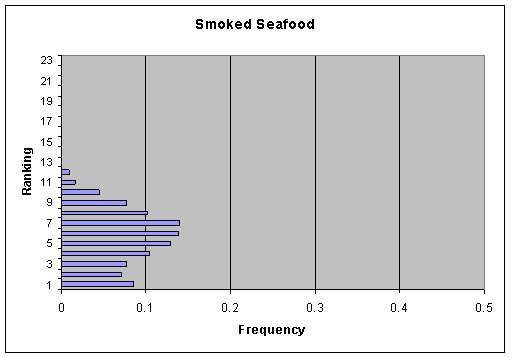
Figure V-4a. Rankings of Total Predicted Listeriosis Cases per Serving for Smoked Seafood
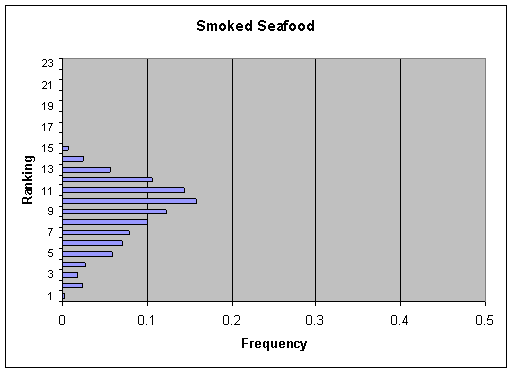
Figure V-4b. Rankings of Total Predicted Listeriosis Cases per Annum for Smoked Seafood
Raw Seafood has a low predicted relative risk per serving of causing listeriosis in the United States. The foods in this category generally were characterized by a low annual number of servings, a low percent of the population consuming the food, and small serving sizes. However, the contamination levels at retail were high and Listeria can grow in these foods at moderate rates. As perishable foods, storage times are typically short which effectively limits the growth and the numbers of organisms likely to be consumed. This combination of factors made the predicted estimates of exposure and illness low. Though the Raw Seafood category has a low predicted relative risk of causing listeriosis in the United States, products in this category have been linked to an outbreak in New Zealand and to a sporadic case in Italy (Farber and Peterkin, 1991).
This category is fairly heterogeneous. Foods for which there were consumption data were flounder, pompano, tuna, sturgeon roe, squid, oysters, and sushi. The median amount consumed per serving is 16.0 g (approximately 0.5 ounce), and the annual total number of servings is low at 1.8 x108.
Forty-six contamination studies (including 11 from the United States) analyzed over 15,500 samples of uncooked seafood and seafood products, primarily to determine the presence or absence of Listeria monocytogenes. Four studies provided quantitative data.
Contamination data were mainly for fresh or frozen whole animals, but products such as cakes, fingers, minces, sushi, and unspecified fish parts are also included. These can be categorized as finfish and non-finfish. Finfish, when specified, included butterfish, catfish, red snapper, trout, and tuna. Both wild caught and aquaculture-reared fish were included. Non-finfish included shellfish and crustaceans. Among the specified foods were lobster, squid, langostino, oyster, shrimp, mussel, clams, and scallops. The percentage of samples with detectable contamination was high (7.0%). Pathogen levels were predicted to be in the high range for the percentage of servings with 103 to 106 cfu at retail.
Six papers provided Listeria monocytogenes growth rates in these foods. Individual foods were trout, catfish, shrimp, and oysters. The growth rates averaged 0.15 logs per day at 5°C. Storage times were relatively short for these foods; the most likely storage time was 1 to 2 days, and the maximum time was 10 to 20 days.
The predicted median risk per serving for the Raw Seafood category was 2.0x10-11 and ranked 13th for the total United States population. The range for the per serving ranking distribution (Figure V-5a) is relatively narrow and concentrated in the lower risk ranks. This indicates that there is little uncertainty associated with the predicted per serving relative risk ranking for the Raw Seafood category. The predicted median per annum relative risk ranking was 18th for the total United States population. The range for the per annum ranking distribution (Figure V-5b) was narrow, indicating that there is also little uncertainty associated with the per annum predicted relative risk for Raw Seafood. This decrease in the per annum ranking compared to the per serving ranking is consistent with the small number of servings consumed per year.
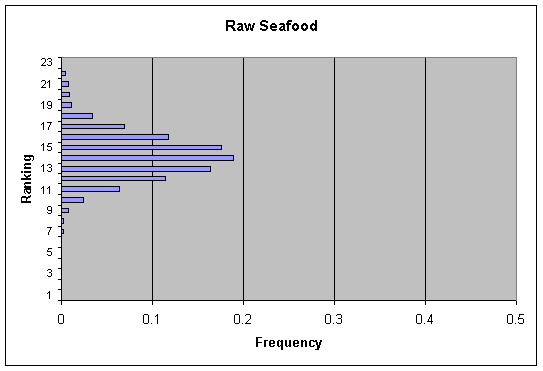
Figure V-5a. Rankings of Total Predicted Listeriosis Cases per Serving for Raw Seafood
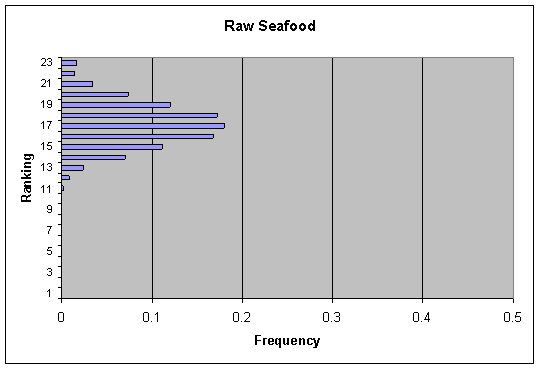
Figure V-5b. Rankings of Total Predicted Listeriosis Cases per Annum for Raw Seafood
Preserved Fish, including pickled, marinated, or dried products, had a low predicted relative risk of causing listeriosis on a per serving basis and a low predicted contribution to the total number of cases on a per annum basis. The foods in this category had a low annual number of servings and a low percent of the population consuming the food, but had moderate serving sizes, high frequency of contamination, and moderate contamination levels at retail. Growth was not modeled for this category, since preserved fish do not support growth. Typically, the inability of a food category to support the growth of Listeria monocytogenes results in a low per serving relative risk. However, in this instance the lack of growth appears to be offset by the frequency of contamination at retail. Moderate level contamination likely occurs because foods in the Preserved Fish category are often prepared using traditional techniques, which require long processing times and occasionally may not meet stringent sanitary standards. This creates the potential for substantial growth of Listeria monocytogenes during initial production steps (e.g., brining) before the product equilibrates to the salt and pH levels that are the basis of preservation. Gravad rainbow trout has been linked to an outbreak of listeriosis in Sweden (Ericsson et. al., 1997).
The Preserved Fish category includes consumption data for pickled or marinated fish, such as ceviche and pickled herring, dried and salted cod, and non-specified dried fish. The median amount consumed per serving for this category is 70 g (approximately 2.5 ounces), and the annual total number of servings is 1.1 x 108.
Contamination data for this food category was from 18 studies. Haddock, gravad trout, ceviche, and unspecified finfish that were pickled, smoked, dried, salted, or preserved were included. Of these studies only one was from the United States. Five studies contained quantitative data. The percentage of samples with detectable contamination was 9.8%, higher than for Raw Seafood, but just slightly less than Smoked Seafood. The predicted percentage of servings contaminated with 103 to 106 cfu at retail was moderate.
Because these products do not allow growth of Listeria monocytogenes, storage times are not a factor in the levels of Listeria monocytogenes present at the time of consumption. Although not a factor, storage times were also believed to be somewhat shorter than those for Smoked Seafood. The high salt and acidity present in the final products prevent growth of Listeria monocytogenes. However, the microorganism is known to survive these conditions, particularly if held at refrigeration temperatures.
The predicted median risk per serving for the Preserved Fish category was 2.3x10-11, which corresponds to a relative risk rankings of twelfth for the total United States population. The range for the per serving relative ranking distribution is relatively broad (Figure V-6a) with a bimodal distribution. The wide spread indicates a high degree of uncertainty which likely is due to a combination of the limited quantitative data and broad variability in conditions under which these products are produced. The bimodal distribution may indicate that there are differences among different foods within this food category, and may require that the category be subdivided if additional data become available in the future in order to achieve a more accurate measure of the relative risks associated with the different foods. The predicted median per annum relative risk ranking was low, at less than one case per annum and ranked nineteenth for the total United States population. The range for the per annum ranking distribution was also a bimodal distribution (Figure V-6b), again indicating a substantial degree of uncertainty or variability. Overall this food category is not predicted to make a substantial contribution to the cases of listeriosis in the United States, however, the uncertainty in the risk per serving indicates that it may be a concern for the small population that consumes these products.
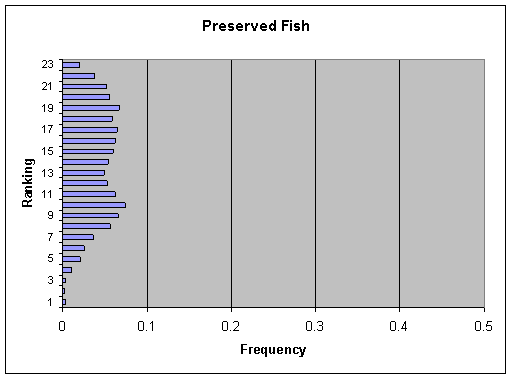
Figure V-6a. Rankings of Total Predicted Listeriosis Cases per Serving for Preserved Fish
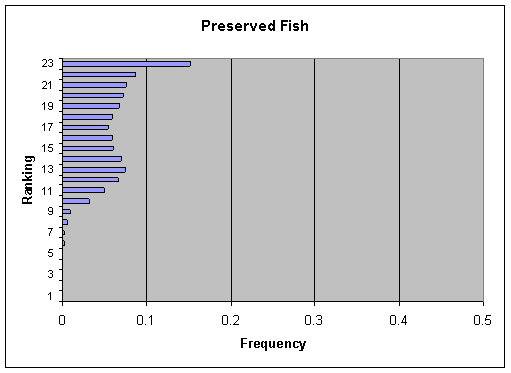
Figure V-6b. Rankings of Total Predicted Listeriosis Cases per Annum for Preserved Fish
Cooked Ready-to-Eat (RTE) Crustaceans (crab and shrimp) had a high predicted relative risk of causing listeriosis in the United States on a per serving basis. The foods in this category generally were consumed at a low frequency and with moderate serving sizes. The relatively high growth rate of Listeria monocytogenes in these foods, one of the usual factors that drives listeriosis risk in food, was offset by relatively short storage times. It would be expected that the cooking step in the preparation of these foods would eliminate Listeria monocytogenes. However, foods in this category may often be stored refrigerated after cooking, allowing for recontamination and growth.
Imitation crabmeat has been linked to an outbreak of listeriosis in Canada and shrimp was epidemiologically linked to an outbreak in the United States. (Ryser, 1999a; Riedo et al., 1994). The FDA has also monitored recalls for cooked shrimp and crab.
The Cooked RTE Crustaceans category includes consumption data for steamed, hard shell crab; steamed or boiled shrimp; and cocktail shrimp. The median serving size for this category was
50 g (approximately 1.8 ounces), and the annual total number of servings was 5.5x108.
Eleven contamination studies provided data mainly from cooked crab and shrimp. Four studies were for product in the United States. Two studies, both from the United States, provided quantitative data. The percentage of contaminated samples was moderate at 2.8%. A small number of samples with high contamination levels (greater than 103 cfu/g) have been reported. The predicted percentage of servings with 103 to 106 cfu/serving at retail was moderate. Only three papers were found that reported growth rates for pasteurized crab and for cooked shrimp and lobster. This category had the fastest reported growth rates of any food category, averaging 0.38 logs/day at 5° C. Storage times were estimated to be relatively short; the most likely storage time was only 1 to 2 days, and the maximum time was 10 to 20 days.
The predicted median risk per serving for the Cooked RTE Crustaceans category of 5.1x10-9 corresponded to a relative risk ranking of sixth for the total United States population. The range for the per serving ranking distribution for Cooked RTE Crustaceans (Figure V-7a) is narrow and concentrated in the lower risk rankings (i.e., a higher risk food). This indicates that there is little uncertainty associated with the predicted per serving relative risk for the Cooked RTE Crustaceans category. The predicted median per annum risk is approximately three cases of listeriosis per annum and a relative risk ranking of eighth for the total United States population. The range for the per annum ranking distribution is narrow and generally normally distributed (Figure V-7b), suggesting relatively little variability or uncertainty in the extent to which this food category is consumed.
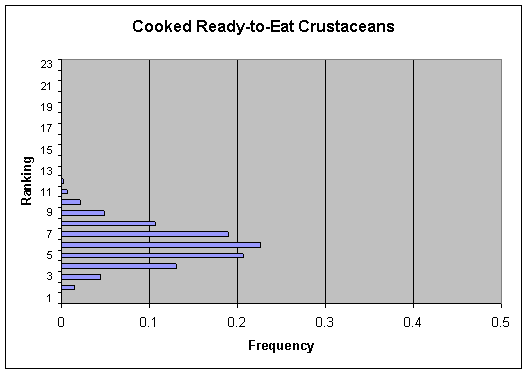
Figure V-7a. Rankings of Total Predicted Listeriosis Cases per Serving for Cooked Ready-to-Eat Crustaceans
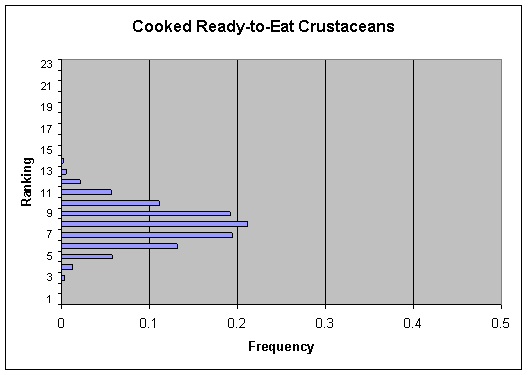
Figure V-7b. Rankings of Total Predicted Listeriosis Cases per Annum for Cooked Ready-to-Eat Crustaceans
Foods in the Vegetables category had a low predicted relative risk of causing listeriosis in the United States on a per serving basis. The Vegetables category is difficult to characterize because it encompasses a diverse set of products that are typically consumed without cooking. The annual number of servings of Vegetables is high, while the median serving size, contamination level, and growth rate are low. The storage time and the contamination frequency are moderate.
Both raw and processed vegetables have been implicated in outbreaks. Raw vegetables have been linked to outbreaks of listeriosis in Austria and Western Australia; frozen broccoli, cauliflower, celery, tomatoes, and lettuce in the United States (Ryser, 1999a; Simpson, 1996; Riedo et al., 1994; Farber and Peterkin, 1991; Allerberger and Guggenbichler, 1989). In addition, raw vegetables have been linked to sporadic cases in Australia, the U.K. (English lettuce, vegetable rennet), and Finland (salted mushrooms) (Ryser, 1999a; Farber and Peterkin, 1991).
Foods included in the Vegetables category are raw as well as mixed vegetable salads that contain raw vegetables but not salad dressing. In addition to vegetables typically consumed raw (e.g., spinach, carrots, tomatoes, celery, lettuce, onions), this category includes less frequently consumed vegetables such as artichokes, sprouts, and raw seaweed. However, salads such as cole slaw and potato salads are included in the Deli-type Salads food category because of the creamy dressing base and frequent handling in the retail deli. The median amount consumed per serving for this category is 28 g (i.e., ~ 1 ounce), and the annual total number of servings is 8.5x1010. The low median serving size most likely reflects the consumption patterns associated with the wide span of vegetable types included in the analysis, though certain vegetables may be eaten in substantially larger amounts (e.g., tomatoes).
Thirty-two contamination studies were found that examined individual raw vegetables or mixed vegetables (without dressing). Of these studies, five were from the United States and eight contained quantitative data. The vegetables analyzed included raw bean sprouts, broccoli, cabbage, carrot, celery, cilantro, cress, cucumber, fennel, legumes, lettuce, mushrooms, parsley, green peppers, onions, radish, scallion, tomato, and watercress. The NPFA (2002) survey collected 2,963 samples of bagged, precut leafy salads and found 2.3% positive, with one sample containing between 102 and 103 cfu/g. Overall, the percentage of samples with detectable contamination was a moderate 3.6%. The predicted percentage of servings with high contamination levels was low.
Nine papers provided 26 estimates of growth rates for Listeria monocytogenes on vegetables. The vegetables included in these studies were lettuce, cabbage, broccoli, cauliflower, asparagus, tomatoes, and carrots. The average growth rate of Vegetables was slow, 0.07 logs/day at 5°C. Moderate storage times were assumed with the most likely 3 to 4 days and the maximum of 8 to 12 days.
The predicted median risk per serving for the Vegetables category was 2.8x10-12 and the relative risk ranking was eighteenth for the total United States population. The range for per serving distribution for Vegetables (Figure V-8a) is similar to what was observed with most food categories and clustered in the lower risk rankings. This indicates that there is relatively little uncertainty associated with the predicted per serving relative risk for the Vegetables category. The predicted median per annum risk was less than one case and the corresponding relative risk ranking was twelfth for the total population. The per annum ranking distribution (Figure V-8b) had a relatively broad range, indicating substantial uncertainty. The distribution was shifted to the higher risk ranks compared to the per serving distribution. These results presumably reflect the large number of servings of Vegetables consumed, as well as the variability in the products encompassed in this highly diverse category. The broad range suggests that this food category and its ranking could benefit from additional investigations and the possible subdivision of the food category into several smaller groupings.
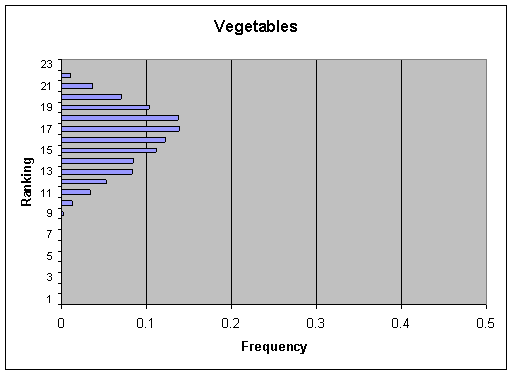
Figure V-8a. Rankings of Total Predicted Listeriosis Cases per Serving for Vegetables
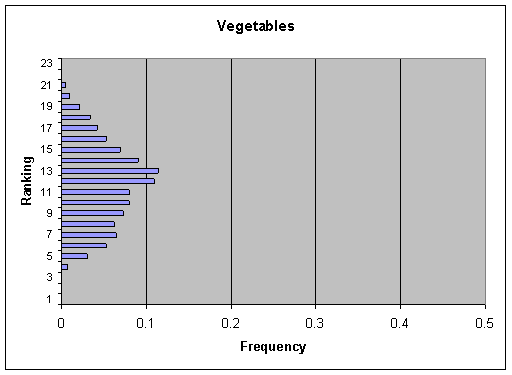
Figure V-8b. Rankings of Total Predicted Listeriosis Cases per Annum for Vegetables
Foods in the Fruits category had a low predicted relative risk of causing listeriosis on a per serving basis. Fruits have not been linked to outbreaks or sporadic cases of listeriosis, and this might explain why there is little contamination data in the published literature available for this category. The annual number of servings, median serving size and contamination frequency of Fruits are high. These factors lead to a high risk for fruits on a per annum basis even though the growth of Listeria monocytogenes during storage would be low. The high level of uncertainty indicates a need for more information and data for this food category. This is a diverse food category that includes acidic fruits (such as pineapples) and pH neutral fruits (such as cantaloupes).
The Fruits category includes consumption data for many types of raw and dried fruits, as well as fruit salads (with fruits as the main ingredient without salad dressing). This category is simplified from the 2001 draft risk assessment in that fruit salads containing salad dressing were moved to the Deli-type Salad food category. The median amount consumed per serving for this category is 118 g (i.e., slightly over 4 ounces), and the annual total number of servings is 4.9x1010.
Only four contamination studies, two of which were from the United States were available. None of these studies included quantitative data. Fruits specified in these studies included apples, blueberries, cantaloupes, pears, pineapples, and fruit products. The percentage of samples with detectable contamination was 11.8%, a high contamination frequency. The contamination levels were estimated from the presence/absence data assuming the standard deviation of the frequencies of contamination levels. The high frequency of contamination would indicate that high levels of contamination could also occur.
Two studies (orange juice and fresh apple slices) were found that characterized the rate of Listeria monocytogenes growth in fruits. When the pH was less than 4.8, Listeria monocytogenes did not grow. At pH 5.0, growth was slow, at 0.05 logs/day. Moderate storage times were assigned for this category, with a most likely time of 3 to 4 and a maximum time of 8 to 12 days.
The predicted median risk per serving for the Fruits category was 1.9x10-11 which corresponds to a relative risk ranking of fourteenth for the total United States population. The range for the ranking distribution for Fruits (Figure V-9a) is broad. The predicted median risk per annum is approximately 1 case per year and the relative risk ranking is tenth for the total United States population (Figure V-9b). This increase in relative risk compared to the per serving value reflects the large number of servings consumed annually. The range for the ranking distribution was broad indicating substantial uncertainty in the predicted relative risk ranking. This likely reflects the limited data available, the diversity of the products that fall within this food category, and the variability in the frequency and extent of contamination rates among the data that were evaluated. The bimodal nature of the distribution suggests that the food category may need to be subdivided when additional data become available. Overall, the Fruits category is a broad category with varied consumption and contamination, and few data were available to characterize this category. Thus, there is a high degree of uncertainty associated with this category.
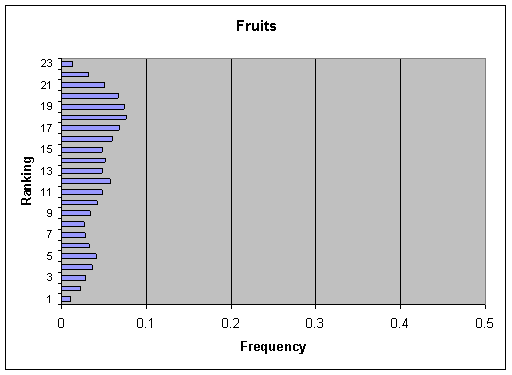
Figure V-9a. Rankings of Total Predicted Listeriosis Cases per Serving for Fruits
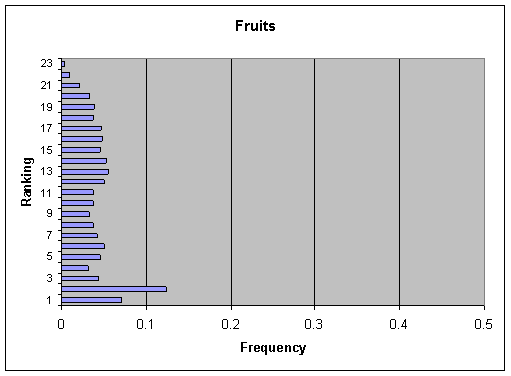
Figure V-9b. Rankings of Total Predicted Listeriosis Cases per Annum for Fruits
Fresh Soft Cheese had a low predicted relative risk of causing listeriosis on a per serving basis. These cheeses are high moisture (>50%) fresh cheeses consumed shortly after manufacture. This category includes traditional Hispanic-style soft cheese (sometimes made from raw, unpasteurized fluid milk) such as panela, Queso de Crema, Queso Fresco,and Queso de Puna. The 2001 draft risk assessment included Queso Chihuahia and Queso Asadero attributed to this category, but these cheeses were moved from this category because they are not fresh, high moisture cheeses. The contamination level at retail, contamination frequency, growth rate during storage, and the annual number of servings are all low.
Fresh Soft Cheese (suspected to be made from unpasteurized milk) has been linked to both outbreaks and sporadic cases of listeriosis in the United States (Ryser, 1999a; Linnan et al., 1988; CDC, 2001), including an outbreak in Los Angeles in 1985 and one in North Carolina in 2001. The 1985 outbreak in Los Angeles was the incident that convincingly established Listeria moncytogenes as an important serious foodborne pathogen. In 2000/2001, an outbreak in the Carolinas associated with homemade cheese made from unpasterurized milk resulted in 12 cases of serious listeroisis.
Consumption data was only available for one type of Fresh Soft Cheese, Queso fresco. The median amount consumed per serving for this category is 31 g (just over 1 ounce), and the annual number of servings is 7.1x107. Data are not available to estimate the proportion of Fresh Soft Cheese that is consumed in the United States made from unpasteurized milk; however, since the initial outbreak there has been a concerted effort to reduce the consumption of soft fresh cheeses made from unpasteurized milk. Fresh soft cheese made from unpasteurized milk does not meet FDA standards for interstate commerce.
Data from eight contamination studies were used to model the frequency of contamination for the Fresh Soft Cheese category. Cheeses in these studies were described as Hispanic-style, Queso Fresco, panela, requesoy, and fresh cow and goat milk cheeses. The most recent study was the NFPA (2002) survey and the contamination levels found in this study were much lower than those previously observed. In that study, 5 contaminated samples out of 2,936 total samples were positive, all at a level of less than 100 cfu/g. The samples from the NFPA study were collected in retail stores and were most likely made from pasteurized milk. Products made outside the retail system (including those made from unpasteurized milk) were not reflected in the NFPA survey. A 'what if' scenerio test was conducted to allow a comparison of the expected estimate of the risk per serving for fresh soft cheese made from pasteurized vs. raw, unpasteurized milk (see below).
Only one growth rate study with these cheeses was available. That study reported a low growth rate of 0.082 logs/day when adjusted to 5° C. The assumed storage times for Fresh Soft Cheese were 1 to 5 days and 15 to 30 days for most likely and maximum times, respectively.
The median risk per serving for the Fresh Soft Cheese category of 1.7x10-10 corresponds to a relative predicted risk ranking of tenth for the total United States population. The range for the predicted per serving risk ranking distribution for Fresh Soft Cheese (Figure V-10a) is relatively narrow and concentrated in the middle of the risk rankings. This indicates that there is little uncertainty associated with the per serving predicted relative risk for the Fresh Soft Cheese category. The predicted median per annum risk was less than one case per year and the relative risk ranking was fourteenth for the total United States population. The range for the per annum ranking distribution is concentrated in the higher risk rankings (Figure V-10b) indicating a lower risk. The breadth of the range indicates that there was somewhat more uncertainty associated with the per annum predicted relative risk ranking for the Fresh Soft Cheese category. This is likely associated with variability in the number of servings and the serving sizes.
An area of uncertainty associated with this food category that is not captured in this risk assessment is the consumption of "homemade" soft cheeses made from raw, unpasteurized milk. Raw milk soft cheeses are not produced and marketed through typical commercial means and have in the past been illegally brought into the United States. Data on such cheeses are not captured in the contamination data base used to develop this risk assessment. However, we recognize that a substantial portion of soft cheeses consumed in the United States may be made from unpasteurized milk.
Scenario Testing: Fresh Soft Cheese Made From Contaminated Unpasteurized Milk
Unlike the 2001 draft risk assessment, the revised risk assessment indicates that the risk from Fresh Soft Cheese is low. This change is largely attributable to the inclusion of additional new data indicating a very low prevalence rate in this food category. However, in the past there has been a strong epidemiological correlation between Hispanic-style fresh soft cheese (Queso Fresco) and listeriosis. A likely explanation for this discrepancy is that the data collected for this category is not representative of the cheese linked to the disease (i.e., fresh soft cheese made from raw, unpasteurized milk). In particular, although most commercial sources of fresh soft cheese are manufactured from pasteurized milk, some sources of queso fresco are made from raw milk. Many of these sources appear to be restricted to specific local areas and have not had the benefit of FDA oversight.
To characterize the risk from highly contaminated queso fresco an exposure model was constructed using the same analog as in the 2001 draft risk assessment - soft unripened cheese made from raw milk (Loncarevik, et al., 1995), where 50% of the samples tested were positive. The tested 'high prevalence' scenario increased the predicted risk on a per serving basis approximately 40-fold for the perinatal and elderly subpopulations. (For additional details, see Chapter VI 'What-If' Scenarios.)
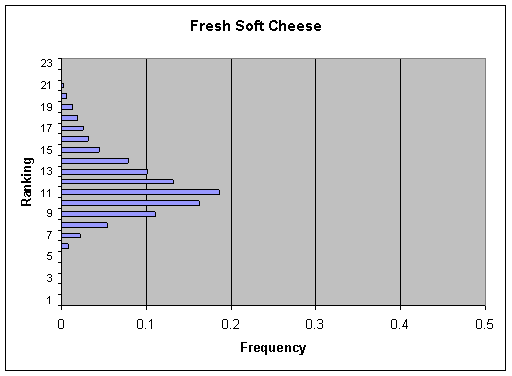
Figure V-10a. Rankings of Total Predicted Listeriosis Cases per Serving for Fresh Soft Cheese
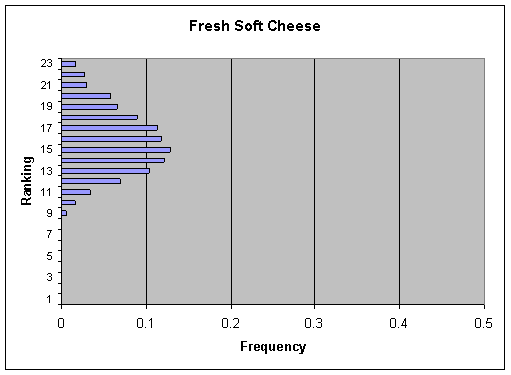
Figure V-10b. Rankings of Total Predicted Listeriosis Cases per Annum for Fresh Soft Cheese
The Soft Unripened Cheese category has a moderate predicted relative risk of causing listeriosis on a per serving basis. The cheeses in this category have moderate frequency and levels of contamination and can have a long storage time. However, they support only a low rate of growth. Serving sizes are typically low, whereas the annual number of servings and contamination levels at retail are moderate. There was a sporadic listeriosis case in the United States linked to the consumption of a highly contaminated ricotta cheese (Ryser, 1999a). There are no reported cases of listeriosis associated with consumption of cottage and cream cheese, but there have been FDA recalls of cream cheese products.
The category represents high moisture (>50%), white curd varieties such as cottage cheese, baker's cream, and American-type Neufchatel cheese. Milk to be manufactured into soft unripened cheese is coagulated through the production of acid by the starter culture (or by direct acidification of milk) rather then by addition of a coagulant. Unlike fresh soft cheese, the refrigerated shelf-life is typically up to 60 days.
Consumption data available were available for cottage, cream, and ricotta cheeses. The median amount consumed per serving for this category is 29 g (about 1 ounce), and the annual total number of servings is 4.4 x 109.
There were eight studies with contamination data for these cheeses, with two from the United States. Three quantitative studies provided quantitative data. Cheeses in the contamination database included Anari, Halloumi, farmer, gournay, Quark, and cottage cheese. Of the 32 positive samples, four samples contained over 500 cfu/g and four samples over 106 cfu/g. The percentage of positive samples was 3.9%.
Twenty-nine data sets provided data on the growth or survival of Listeria monocytogenes in these cheeses. Nine of these studies showed a decline in levels over time. The research literature indicates that growth or decline of Listeria monocytogenes in these low salt cheeses is largely dependent upon pH. For example, ricotta cheese (pH=5.9 to 6.1) permitted rapid growth, whereas declines were observed in some cream cheeses (pH=4.8). The growth rates were standardized to 5 °C and a distribution fitted to the data to allow growth or decline (i.e., negative growth) in proportion to the available data. The average growth rate was 0.09 logs/day. Storage times were relative long, with the most likely 6 to 10 days and the maximum 15 to 45 days.
The median risk per serving for the Soft Unripened Cheese category of 1.8x10-9 corresponds to a relative predicted risk ranking of eighth for the total United States population. The range for the predicted per serving risk rankings for Soft Unripened Cheese (Figure V-11a) is bimodal but concentrated in the higher risk rankings. This indicates some uncertainty associated with the per serving predicted relative risk for this category. The median per annum risk was predicted as approximately 8 cases per year and the relative risk ranking was fifth for the total United States population. The range for the per annum ranking distribution is concentrated in the lower risk rankings, which corresponds to a higher risk (Figure V-11b). However, the broad ranges in uncertainty likely result from the differences of the products in this food category to support growth or cause a decline in levels of Listeria monocytogenes. Based on these results, this food category could benefit from subdivision.
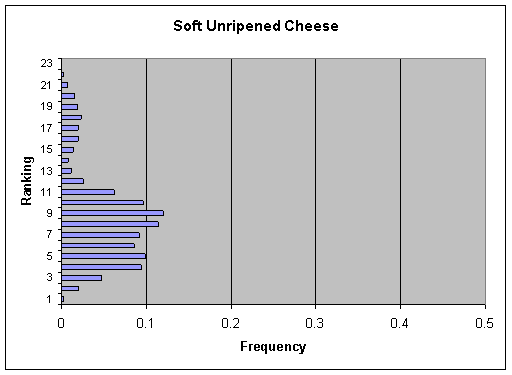
Figure V-11a. Rankings of Total Predicted Listeriosis Cases per Serving for Soft Unripened Cheese
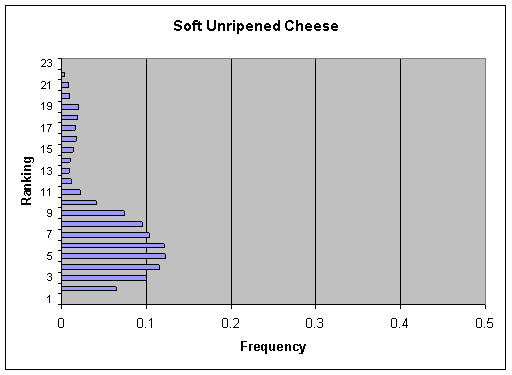
Figure V-11b. Rankings of Total Predicted Listeriosis Cases per Annum for Soft Unripened Cheese
The cheeses in the Soft Ripened Cheese food category had a low predicted relative risk of causing listeriosis in the United States on a per serving basis. This food category includes high moisture (>50%), ripened cheeses such as mold surface-ripened cheeses (Brie, Camembert), pickled (white brined) cheeses, feta, and soft Italian-style cheeses (mozzarella). There are a moderate number of annual servings and small serving sizes. Growth rates were low but, contamination frequencies and levels at retail were moderate and storage times were long. Soft Ripened Cheeses including mold-ripened cheeses have been linked to outbreaks of listeriosis in Denmark, France and Switzerland and linked to sporadic cases in Belgium, Canada, and the U.K (Ryser, 1999a; Riedo et al., 1994; Art and Andre, 1991; Farber and Peterkin, 1991). There have not been any confirmed reports of sporadic cases or outbreaks associated with these cheeses in the United States.
The median amount consumed per serving for this category is 28 g (~1 ounce) and the annual number of servings is 1.9x109. Data are not available on the proportion of United States or imported cheese that is made from unpasteurized fluid milk. Market data indicate that the United States imports approximately 50% of the Camembert and Brie Cheese and 20% of the feta cheese sold in the United States (National Cheese Institute, 1998).
Contamination data was obtained for 17 studies with three being from the United States. Five studies provided quantitative data. Brie, Camembert, Feta, and Taleggio are some of the cheeses represented in the contamination data. Of the 17 studies, 6 contained quantitative contamination data. In the 2001 NFPA study, two samples were positive for Listeria monocytogenes with levels less than 10 cfu/g. The frequency of contamination was 3.8%.
Listeria monocytogenes populations were reported in the research literature to both increase and decrease in these cheeses. Of 17 studies, 7 showed declines, one no change, and 9 indicated growth. Therefore, the growth rate distribution used with this food category (-0.013 logs/day) included both growth and decline, with the 'average' response being a slow rate of decline. Storage times for this food category were long, with a maximum of 15 to 45 days.
The median risk per serving for the Soft Ripened Cheese category of 5.1x10-12 corresponds to a relative predicted risk ranking of seventeenth for the total United States population. The range for the predicted per serving risk ranking distribution for this category (Figure V-12a) is broad but concentrated in the higher risk rankings (low predicted risk). This indicates substantial uncertainty associated with the per serving predicted relative risk for this category resulting from the ability of some of these cheeses to support growth of Listeria monocytogenes and other cheeses to cause a decline. The median per annum risk was predicted as less than one case of listeriosis per year and the relative risk ranking was sixteenth for the total United States population. With the wide range for the per serving rankings, the resulting range for the per annum ranking distribution is quite broad (Figure V-12b) indicating high uncertainty associated with the per annum predicted relative risk ranking.
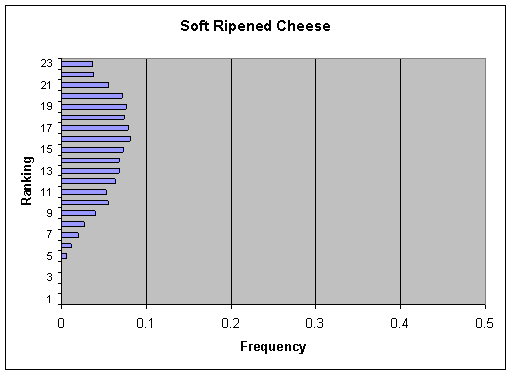
Figure V-12a. Rankings of Total Predicted Listeriosis Cases per Serving for Soft Ripened Cheese
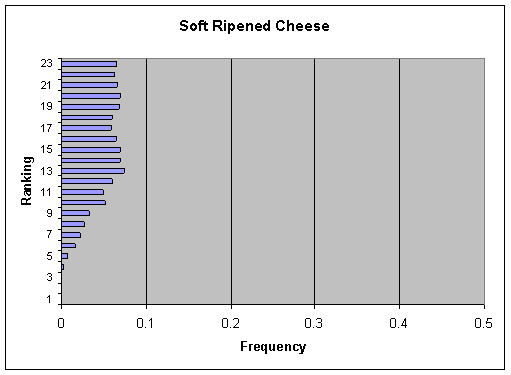
Figure V-12b. Rankings of Total Predicted Listeriosis Cases per Annum for Soft Ripened Cheese
The Semi-soft Cheese food category has a low predicted relative risk of causing listeriosis on a per serving basis. Semi-soft Cheese has a moisture content that ranges between 39% and 50%. The cheeses in this food category include blue, brick, Edam, Gouda, havarti, Limburger, Monterrey jack, Muenster, and provolone. The serving sizes are small, the annual number of servings, and contamination frequency are moderate, and the levels at retail are low. Although the storage times are long, the growth rates are low. Blue cheese has been linked to an outbreak of listeriosis in Denmark (Jensen et al., 1994) and Monterrey jack cheese made from raw milk to a sporadic case in the United States (Ryser, 1999a). FDA has monitored recalls of several semi-soft cheeses because of the presence of Listeria monocytogenes.
The median amount consumed per serving for this category is 28 g (1 ounce), and the annual number of servings is 1.8x109. Data are not available to describe the proportion of United States or imported cheese that is made from unpasteurized fluid milk. Market data indicate that the United States imports approximately 20% of the blue cheese (including Gorgonzola) sold in the United States (National Cheese Institute, 1998).
There were eleven studies with contamination data, including three from the United States. Three studies provided quantitative data. The average frequency of contamination from these studies was 3.1%. The recent NFPA survey (NFPA, 2002) collected 1,623 samples of semi-soft cheeses, of which 23 were positive. The highest contamination observed was less than 100 cfu/g.
Semi-Soft Cheeses do not generally permit growth of Listeria monocytogenes. Of the 10 data sets found in the literature, levels declined in eight studies and the mean exponential growth rate was -0.043 logs/day at 5 °C. The storage times were long with a maximum of 15 to 45 days.
The median risk per serving for the Semi-soft Cheese category of 6.5x10-12 corresponds to a relative predicted risk ranking of sixteenth for the total United States population. The range for the predicted per serving risk ranking distributions for this category (Figure V-13a) is relatively narrow and concentrated in the higher risk rankings (low predicted risk). This indicates relatively little uncertainty associated with the per serving predicted relative risk for this category. The median per annum risk was predicted as less than one case of listeriosis per year and the relative risk ranking was fifteenth for the total United States population. As with the range for the per serving rankings, the range for the per annum ranking distribution is similar to that typical of most food categories (Figure V-13b) indicating relatively little uncertainty associated with the per annum predicted relative risk ranking.
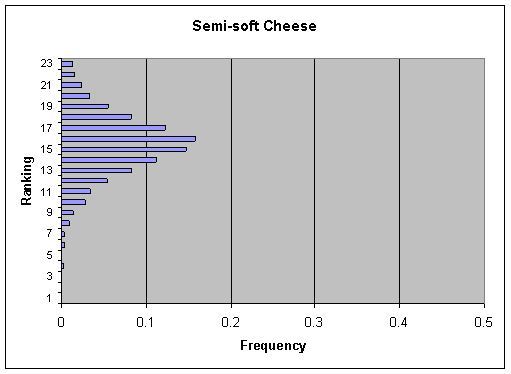
Figure V-13a. Rankings of Total Predicted Listeriosis Cases per Serving for Semi-soft Cheese
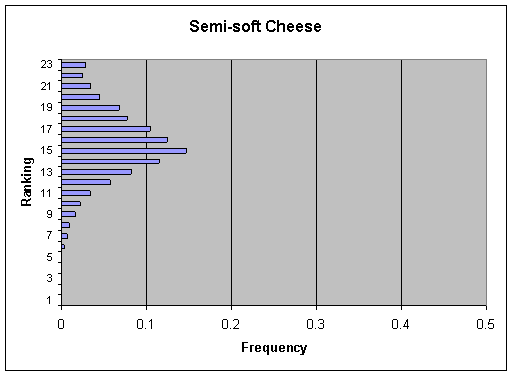
Figure V-13b. Rankings of Total Predicted Listeriosis Cases per Annum for Semi-soft Cheese
The Hard Cheese food category had a low predicted relative risk of causing listeriosis on a per serving basis. The low relative risk can be attributed to the small amount consumed, low contamination level at retail, and little, if any, growth during storage, despite the long storage times, and a moderate annual number of servings. Hard Cheeses have less than 39% moisture and include cheddar, Emmemtaler, Gruyere, parmesan, Queso Chihuahua, romano, silton, and Swiss. These types of cheeses typically have a high salt content, which limits the growth of Listeria monocytogenes. There are no recognized outbreaks or illnesses traced to Hard Cheese.
This cheese category includes consumption data for a variety of cheese types, including Swiss, cheddar, and parmesan. The median amount consumed per serving for this category is 28 g (~1 ounce) and the annual number of servings is 9.0x109.
Twelve studies, including two from the United States, provided contamination data for this category. Two studies provided quantitative data. Some of the data were collected from 2000 and later but the majority of the data was collected before 1993. The quantititive data were from the U.K, in 1990 and 1991. The frequency of contamination was only 1.4%, a low rate.
Seven studies provided data on the growth and survival of Listeria monocytogenes in hard cheeses. Of the 11 data points available, 10 indicated declines in Listeria monocytogenes populations, with an average of -0.053 logs/day at 5 °C. Storage times for this category of cheese were longer than other cheese categories. The most likely storage time was 6 to 10 days and the maximum was 90 to 180 days.
The median per serving and per annum predicted relative risk ranking for the Hard Cheese category were both last (23rd) for the total United States population. The range of the per serving ranking distribution (Figure V-14a) was moderately narrow and strongly concentrated in the higher rankings (low risk). The per annum ranking distribution (Figure V-14b) is similar to the per serving distribution. This indicated that there was little uncertainty with the predicted rankings.
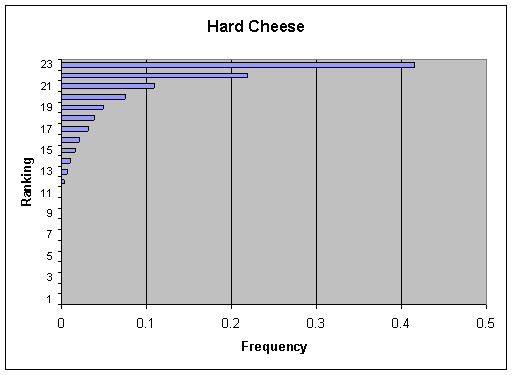
Figure V-14a. Rankings of Total Predicted Listeriosis Cases per Serving for Hard Cheese
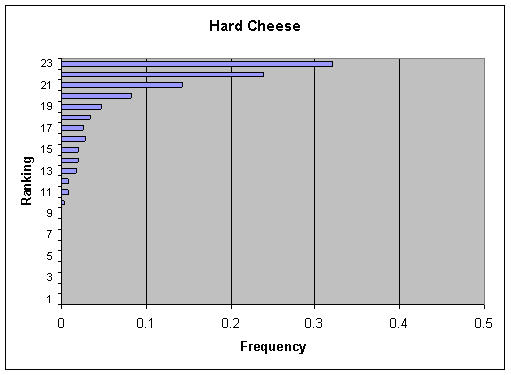
Figure V-14b. Rankings of Total Predicted Listeriosis Cases per Annum for Hard Cheese
The Processed Cheese category had a low predicted relative risk of causing listeriosis on a per serving basis. This category has a high annual number of servings and a long storage time, but a low growth rate during storage and low contamination frequency. The median amount consumed per serving is 21 g (about 0.75 ounce), and the annual total number of servings is 1.2x1010.
Processed cheeses are made with natural cheese, dairy ingredients, and emulsifying salts. These cooked (pasteurized) and packaged cheeses include cheese food, cheese spreads, cheese sauces, and cheese slices. Processed cheeses from this category have not been linked to outbreaks or sporadic cases of listeriosis, but FDA has monitored recalls of cheese foods and cheese spreads because of the presence of Listeria monocytogenes.
There were four contamination studies available for this category, of which one was from the United States. A total of 325 samples were analyzed with only 0.9% found to contain Listeria monocytogenes. In two of these studies, the three positive samples were enumerated with the highest level being less than 100 cfu/g. In two recent studies, the 49 collected samples were negative for Listeria monocytogenes. The predicted percentage of servings with 103 to 106 cfu at retail was low.
Six data points for the survival of Listeria monocytogenes in Processed Cheese were found in the literature. All showed decreasing numbers during storage. Overall, a survival rate of -0.045 logs/day at 5°C was used. Storage times were long for this category; the assumed most likely time was 6 to 10 days and the maximum time was 45 to 90 days.
The median risk per serving for the Processed Cheese category of 4.2x10-14 corresponds to a relative predicted risk ranking of twenty-one for the total United States population. The predicted median per annum relative risk rankings was also twenty-first for the total United States population, with less than one case per year predicted for this food category. Both ranking distributions for Processed Cheese (Figures V-15a and V-15b) are moderately wide and concentrated in the higher rankings (i.e., a lower risk). The degree of uncertainty was slightly greater for the per annum rankings. Overall, there was a moderate degree of uncertainty in both the predicted per serving and per annum predicted relative risk rankings for the Processed Cheese category. This reflects the fact that there was only limited data that were available for this food category.
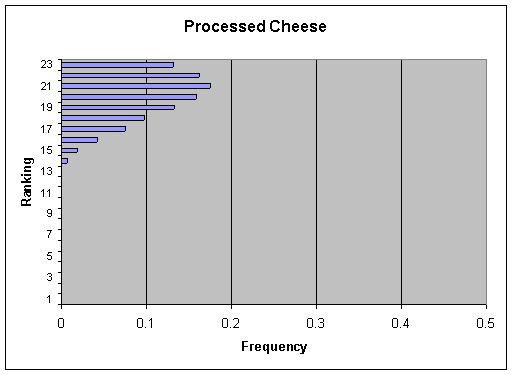
Figure V-15a. Rankings of Total Predicted Listeriosis Cases per Serving for Processed Cheese
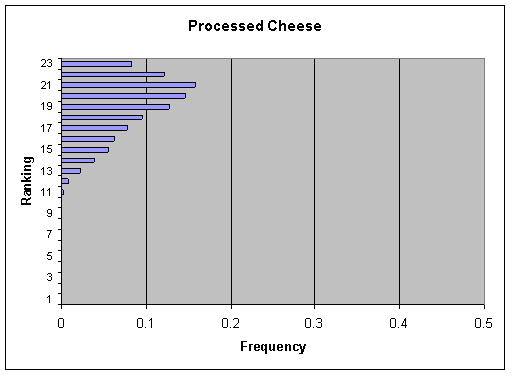
Figure V-15b. Rankings of Total Predicted Listeriosis Cases per Annum for Processed Cheese
Pasteurized Fluid Milk had a moderate predicted relative risk of causing listeriosis on a per serving basis. The Pasteurized fluid milk category includes cow and goat milk, chocolate milk, other flavored milk, and malted milk. This is the most commonly consumed food category. Products in this category are eaten 4 to 100 times more often than foods in most other categories. Powdered milk and other dairy products that are reconstituted by the food preparer and milk shakes were included in the High Fat and Other Dairy Products food category.
Contamination frequency at retail for this category is low (average of 0.4%) due to pathogen inactivation during pasteurization. However, this is offset somewhat by the large serving sizes associated with this product and high potential for growth of Listeria monocytogenes in the product during storage. The median amount consumed per serving is 244 g (approximately 8 ounces), which is substantially larger than the serving sizes of most other foods considered in this risk assessment. The frequency of serving (8.7x1010) is also the highest among the food categories.
It is generally assumed that contamination of Pasteurized Fluid Milk is the result of post-pasteurization recontamination, since normal pasteurization will effectively eliminate the microorganism. One of the most likely sites is during filling which would lead to the occasional recontamination of individual cartons. Accordingly, control of recontamination is likely to be a key factor in further risk reduction. Experimental studies have demonstrated that pasteurized milk will support growth of Listeria monocytogenes to high levels at refrigeration temperatures within the normal shelf-life of the food.
An outbreak of listeriosis has been associated with post-pasteurization recontamination of pasteurized chocolate milk (Dalton, et al., 1997). A second outbreak was epidemiologically linked to pasteurized whole or 2% milk; however, this could not be confirmed by laboratory analyses (Ryser, 1999a; Fleming et al., 1985). Such outbreaks likely represent a significant loss of control whereas the sporadic recontamination of individual contains would be likely to be expected to produce sporadic cases. Sporadic cases would be difficult to identify using traditional case control studies due to the high rate of consumption of this food.
Over 12,400 samples from 30 studies were available to provide data on the frequency of detectable contamination. Most of these studies were from samples collected outside of the United States. Approximately 0.03% of the milk consumed in the United States is imported (Frye and IDFA, 2000a). Two reports (Kozak et al., 1996; Frye and IDFA, 2000b) of surveys conducted in the United States and one survey from Canada were available to estimate the frequency of contamination in North America. The overall frequency of contamination was low at 0.4%. The survey conducted in the United States by the International Dairy Foods Association (Frye and IDFA, 2000b) observed only one positive sample in 4,552 collected samples and the level in that sample was below quantitation (<1 cfu/g). The other studies with enumeration data (conducted in Germany and the U.K.) analyzed a total of 1,559 samples of which only 4 were positive.
Five laboratory investigations of the growth rate of Listeria monocytogenes in pasteurized, unpasteurized, Ultra High Temperature (UHT), skim, and chocolate milks were found. The mean exponential growth rate was 0.26 logs/day, a relatively rapid rate of growth compared with other food categories. In contrast to the other food categories, the literature indicated that milk supported higher maximum levels of Listeria monocytogenes and that the storage temperatures did not affect as much the maximum growth potential in fluid milk. The storage intervals used in the model for storage ranged from 0.5 to 15 days, with 3 to 5 days as the most likely storage time.
The median per serving predicted relative risk rankings for the Pasteurized Fluid Milk category were ninth for the total United States population. The range for per serving ranking distribution for Pasteurized Fluid Milk was moderately broad. The distribution of rankings was normally distributed, and similar to that observed with other food categories (Figure V-16a). Thus, the predicted per serving relative risk ranking was considered to have a moderate degree of uncertainty. The number of servings predicted to contain 103 to 106 cfu/g after refrigerated storage is low. Furthermore, the number of servings associated with the limited quantitative data required the use of a broad distribution for post storage contamination levels. This, in turn, may lead to an overestimation of the relative risk associated with this product.
The median per annum predicted risk was approximately 91 cases per year which corresponds to a relative risk ranking for Pasteurized Fluid Milk of second for the total United States population.
The increase in the predicted per annum relative risk ranking compared to the per serving ranking reflects the frequency of consumption. Pasteurized milk is the most extensively consumed food category both in terms of frequency of consumption and serving sizes. These factors, in combination with the uncertainty associated with the lack of quantitative data for the levels of Listeria monocytogenes in contaminated pasteurized milk results in a small percentage of contaminated servings being assigned a high level of contamination. These few, highly contaminated servings predicted by the model drive the risk estimates.
While the per annum ranking distribution is relatively narrow (Figure V-16b), it is strongly influenced by the highly uncertainty values in the "tails" of the broad distributions that had to be incorporated into the models. Definitive interpretation of the per annum risk and its ranking will have to await the acquisition of additional quantitative data and possibly more sophisticated epidemiologic investigations that could shed more light on the differences between the epidemiologic record and the risk predicted by the current model.
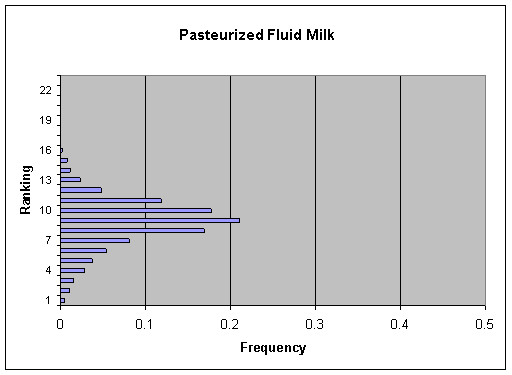
Figure V-16a. Rankings of Total Predicted Listeriosis Cases per Serving for Pasteurized Fluid Milk
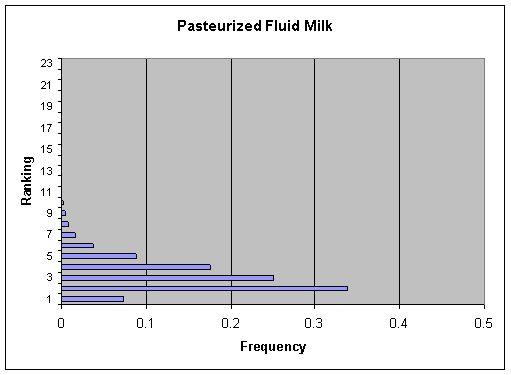
Figure V-16b. Rankings of Total Predicted Listeriosis Cases per Annum for Pasteurized Fluid Milk
Unpasteurized Fluid Milk had a high predicted relative risk of causing listeriosis on a per serving basis. Although consumption of unpasteurized fluid milk is infrequent, relatively large serving sizes and a moderate frequency of contamination, coupled with a significant (high) potential for growth during its refrigerated shelf-life affect the relative risk for this category. The annual number of servings consumed of Unpasteurized Fluid Milk was estimated to be low, 4.4x108 servings (0.5% of pasteurized fluid milk). The median serving size (244 g, or approximately 8 ounces) was assumed to be the same as for pasteurized fluid milk.
Although federal law requires milk in interstate commerce to be pasteurized, some states allow milk consumed within the state to be sold and drunk as unpasteurized milk. Results of a 1995 FDA/CDC survey of all 50 states, Puerto Rico, and the District of Columbia showed that 28 states (54%) permit the sale of unpasteurized milk. In the states where the sale of unpasteurized milk is legal, the estimated volume of unpasteurized milk sold, as a percentage of total milk sold, was less than 1% by volume (or weight) (Headrick et al., 1998). Several studies have shown that Listeria monocytogenes is present in 1 to 6% of unpasteurized milk samples on a worldwide basis. There has been an outbreak linked to unpasteurized milk in Austria and a sporadic case of listeriosis was linked to unpasteurized milk in Denmark (Jensen et al., 1994; Allerberger and Guggenbichler, 1989). The use of unpasteurized milk to manufacture other dairy products has also been linked to outbreaks and sporadic cases of listeriosis.
There were 45 contamination studies, including 10 from the United States. Three studies (all non-United States) provided quantitative data. Almost all of the samples were cow's milk but a small portion was goat or other non-bovine milk. The contamination frequency was moderate at 4.1%. The three recent studies from the United States found a contamination frequency of 1.6%, i.e., 20 positive samples out of 1,263 total samples (Abou-Eleinin et al., 2000; Frye and IDFA, 2000b; and Oregon Dept of Agriculture, 2001).
In general, the initial frequency of contamination is greater in unpasteurized milk than in pasteurized milk, 4.1% vs. 0.4%, respectively. Although the prevalence of low level contamination is much higher in unpasteurized milk than for pasteurized milk, the calculated relative risk per serving is only slightly higher. This appears to be due to two factors. The first is that higher contamination rates are offset somewhat by the shorter storage time assumed for unpasteurized milk. The storage times used in the analysis were 0.5 to 10 days with a most likely time of 2 to 3 days. Because of the presence of a more extensive spoilage microflora, the product tends to be held for a shorter time period than pasteurized milk. The second factor that influenced the predicted per serving relative risk associated with Unpasteurized Fluid Milk is the small degree of variability in the frequency and levels of contamination reported in a large number of studies. This availability of substantially more quantitative data led to a substantially narrower range of contamination values and eliminated the distribution "tails" that increased the uncertainty discussed in the preceding section on Pasteurized Fluid Milk. This emphasizes the impact that the degree of uncertainty has on the calculation of risk.
The predicted percentage of servings contaminated with 106 to 109 cfu/serving at retail was low. Unpasteurized Fluid Milk would be characterized by frequent contamination at low levels. This is in contrast to Pasteurized Fluid Milk, which would have infrequently contaminated cartons. Because unpasteurized milk does not receive any treatment that would reduce Listeria monocytogenes levels, several of the studies used were of bulk tank milk instead of milk in retail containers. The extent to which this might affect the estimated exposure is unclear. Higher median levels of contamination with Listeria monocytogenes might be expected in unpasteurized milk; however, the limited data do not support this.
It has been hypothesized that competition from more numerous spoilage microorganisms present in Unpasteurized Fluid Milk may slow the growth rate of Listeria monocytogenes and also reduce the maximum growth. However, no data were available to allow this to be factored into the risk assessment. There were two growth studies using unpasteurized fluid milk. They did not indicate any clear difference in growth rates compared to pasteurized fluid milk. Therefore, the growth characteristics of the Pasteurized Fluid Milk category were assumed for Unpasteurized Fluid Milk. As indicated previously, while storage times for unpasteurized milk were moderate, the values used were shorter than those for pasteurized milk. If this assumption is not correct, this would lead to a degree of understating the relative risk due to the food category.
The median per serving predicted relative risk rankings for the Unpasteurized Fluid Milk category was fourth for the total United States population (Figure V-17a). The range of the ranking distribution for Unpasteurized Fluid Milk was similar to those observed with the other food categories (Figures V-17a and V-17b) and tended to the lower relative risk rankings (i.e., higher risk). This indicates that there was moderate uncertainty associated with the relative ranking for the Unpasteurized Fluid Milk category. This uncertainty is likely due to the variability in the frequencies and extents of contamination among the different studies. The median per annum predicted relative risk ranking was seventh for the total United States population (Figure V-17b). This decrease in predicted relative risk in comparison to the per serving values reflects the relatively few servings consumed annually. The distribution of per annum rankings was moderately broad and nearly normally distributed, indicating a moderate but typical degree of uncertainty associated with the predicted per annum risk ranking.
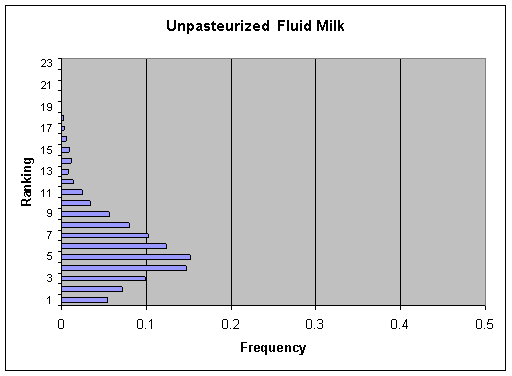
Figure V-17a. Rankings of Total Predicted Listeriosis Cases per Serving for Unpasteurized Fluid Milk
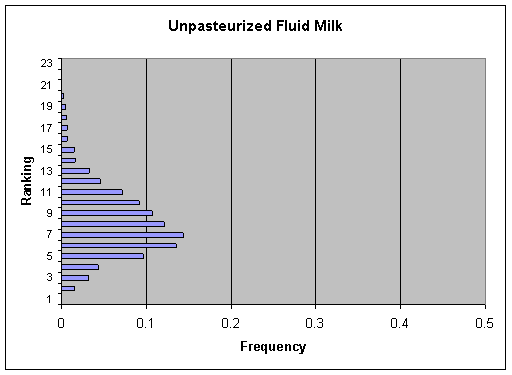
Figure V-17b. Rankings of Total Predicted Listeriosis Cases per Annum for Unpasteurized Fluid Milk
Ice Cream and Frozen Dairy Products had a low predicted relative risk of listeriosis on both a per serving and per annum basis. While ice cream and frozen dairy products are consumed frequently and the median serving size is large, contamination frequency is low and is usually at low levels. Growth is not supported at freezer temperatures. The only association between listeriosis and ice cream or other frozen dairy products was a sporadic case in Belgium, which was linked to commercially prepared ice cream made from contaminated cream (Ryser, 1999a). Like Pasteurized Fluid Milk, contamination of Ice Cream and Other Frozen Dairy Products appears to be largely the result of occasional post-pasteurization recontamination of individual cartons, which would be more consistent with sporadic cases that outbreaks.
Consumption data included many types of ice cream and frozen dairy products. The median amount consumed per serving for this category is 132 g (approximately 4.7 ounces) and the annual number of servings consumed is 1.5x1010.
Twenty-two studies provided contamination data. Five were conducted in the United States and two studies (none from the United States) provided quantitative data. Tested products included ice cream, frozen yogurt, ice milk, ice cream mix, and novelty ice cream products. The percentage of positive samples was low (0.12%). A recent, large quantitative study from Germany (Hartun, 2001) observed only two positive from a total of 1,696 samples and both of these samples contained less than 100 cfu/g of Listeria monocytogenes.
Although Listeria monocytogenes cannot grow at freezer temperatures, it is able to survive. If temperature abuse occurs that permits changes in the texture of these products (i.e., warming and refreezing), the product does not become warm enough to permit Listeria monocytogenes growth. More drastic temperature abuse, of the kind that would allow growth, results in an inedible product. The levels of Listeria monocytogenes found in the retail surveys of ice cream and frozen dairy products would not increase prior to consumption.
The predicted median per serving and per annum relative risk rankings for the Ice Cream and Frozen Dairy Products category were both twentieth for the total United States population. The ranges for both predicted ranking distributions for ice cream and frozen dairy products are clustered in the high rankings (low risk) (Figures V-18a and V-18b). The uncertainty was similar to that observed with other food categories. The extensive database available and the characteristics of the food category provide significant confidence in the relative rankings for the Ice Cream and Other Frozen Dairy Products category.
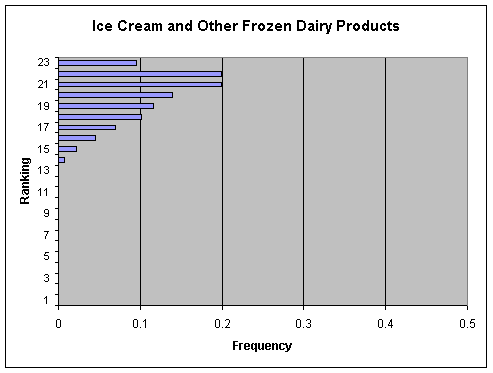
Figure V-18a. Rankings of Total Predicted Listeriosis Cases per Serving for Ice Cream and Frozen Dairy Products
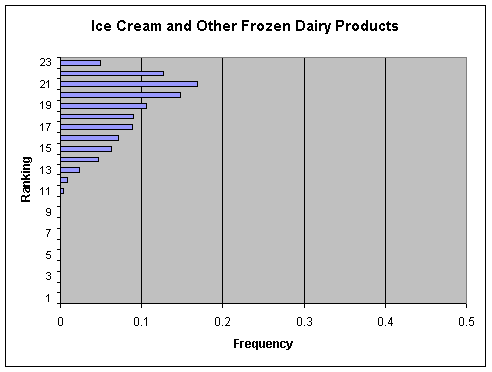
Figure V-18b. Rankings of Total Predicted Listeriosis Cases per Annum for Ice Cream and Frozen Dairy Products
Cultured Milk Products had a low predicted relative risk of listeriosis on both a per serving and per annum basis. The Cultured Milk Products category had a relatively low contamination frequency and levels of contamination. Because of the breadth of the category, there were a moderate number of servings annually, high amounts consumed, and the proportion of the population eating products from this category was high.
The Cultured Milk Products category includes low pH dairy foods manufactured with lactic acid fermentation. Of these foods, yogurt is the most frequently consumed food. Others include buttermilk and sour cream. These products had previously been grouped with High Fat Dairy Products (referred to as the Miscellaneous Dairy Products) in the 2001 draft risk assessment. In this revised risk assessment, the cultured milk products and high fat milk products have been separated into two food categories based on product characteristics. No illnesses have been linked to Cultured Dairy Products.
Consumption data for Cultured Milk Products include many types of dairy products such as buttermilk, yogurt, and sour cream. The median amount consumed per serving for this category is 114 g (slightly over 4 ounces), and the annual number of servings is 7.2x109.
Six contamination studies were available, with the single study conducted in the United States collected only 14 samples. A 1991 study conducted in the U.K. observed four positive samples, one of which was enumerated and contained 103 to 104 cfu/g. The contamination frequency for these studies was low at 0.8%.
Inoculated pack studies showed that Listeria monocytogenes does not grow in these foods. Five data sets for yogurt and buttermilk were averaged and indicate an inactivation rate of -0.17 logs/day. The storage times for these products are relatively long and range from 0.5 to 45 days with the most likely storage time between 6 and 10 days.
With a low frequency of contamination and declining Listeria monocytogenes numbers during a potentially lengthy storage, this food category is predicted to pose a low risk per serving and a low contribution to the total cases per annum. The predicted median per serving and per annum relative risk rankings for the Cultured Milk Products were twenty-second for the total United States population. The ranges for both predicted ranking distributions are broad but clustered in the high rankings (low risk) (Figures V-19a and V-19b). There was more uncertainty for this food category than for other dairy products (such as ice cream), with more iterations having lower rankings. This is largely attributed to the limited data available.
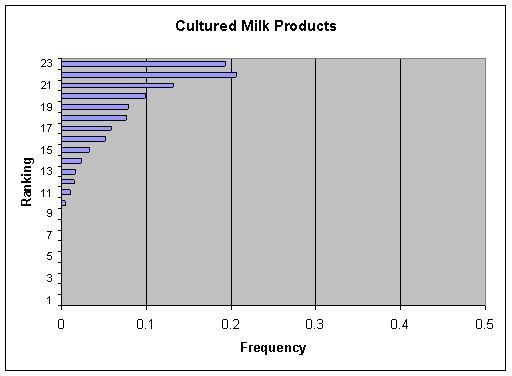
Figure V-19a. Rankings of Total Predicted Listeriosis Cases per Serving for Cultured Milk Products
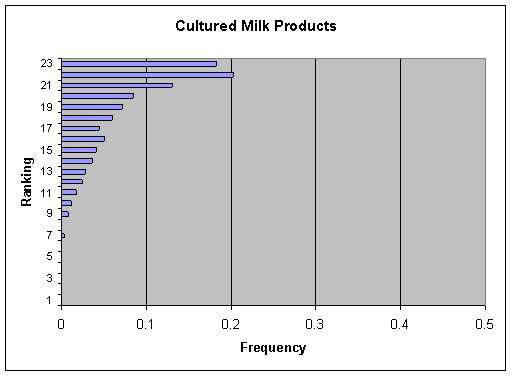
Figure V-19b. Rankings of Total Predicted Listeriosis Cases per Annum for Cultured Milk Products
The High Fat and Other Dairy Products food category had a moderate predicted relative risk of listeriosis on a per serving basis. Although the High Fat and Other Dairy Products category had a relatively low contamination frequency and levels of contamination, Listeria can grow in these products and storage times are typically long. Because of the breadth of the category, there were a high number of servings annually, and the proportion of the population eating products from this category was high. This is offset to a degree by the low amount consumed per serving. These factors resulted in a high predicted relative risk on a per annum basis. Two products, pasteurized cream (in the U.K.) and butter (in the United States and Finland), have been linked to outbreaks of listeriosis (Ryser, 1999a; Lyytikäinen et al., 2000).
The High Fat and Other Dairy Products category consists of high fat dairy products such as butter, cream, half and half, and other dairy products including shakes. These products had previously been grouped with Cultured Milk Products (referred to as the Miscellaneous Dairy Products) in the 2001 draft risk assessment. In this revised risk assessment, the cultured milk products and high fat milk products have been separated into two food categories based on product characteristics. Even with the removal of cultured dairy products from this group, the High Fat and Other Dairy Products category remains a relatively diverse group. Acquisition of additional data to address product-specific questions and subdivision of this category into smaller product groupings may be warranted in the future.
Consumption data for the High Fat and Other Dairy Products include many types of dairy products (milk shakes, cream, and butter). The median amount consumed per serving for this category is 13 g (a little less than 0.5 ounce), and the annual number of eating occasions is 2.1x1010.
Twelve contamination data sets were available for this category, including four from the United States. Two studies (not from the United States) provided quantitative data. The studies comprised 18,169 samples of all types of dairy products, including some unspecified products. The specified products were butter and cream, primarily. It was not typically indicated whether these products, which generally have high water activity, were made from pasteurized or unpasteurized milk. One set of cream samples was reported as being unpasteurized. Microbial analysis of dry milk products, casein, non-fat dried milk, and dry infant formula in their dry state were excluded. Over 40% of the samples were analyzed quantitatively. The percentage of samples with detectable contamination was about 1.3%, a low contamination rate, but the contamination levels were moderate.
Most of the foods in the High Fat and Other Dairy Products category support growth of Listeria monocytogenes. The six data sets ranged from -0.02 to 0.26 logs/day with an average of 0.11 logs/day, a moderate growth rate. The storage times for this category were long. The assumed distribution had a most likely time of 6 to 10 days and a maximum time of 15 to 45 days. The risk assessment did not attempt to estimate the fraction of butter servings left at room temperature; this practice could increase the predicted risks for this food category.
The median risk per serving for the High Fat and Other Dairy Product category of 2.7x10-9 corresponds to a predicted relative risk ranking of seventh for the total United States population. The per serving rankings for High Fat and Other Dairy Products was normally distributed and the range of the distribution was relatively narrow (Figure V-20a), indicating that there is a reasonable degree of certainty associated with the per serving ranking despite the broad range of foods in the category. The predicted median per annum relative risk ranking for the High Fat and Other Dairy Products category was third for the total United States population, representing a median of approximately 56 predicted cases of listeriosis for the total United States population. The range for the per annum ranking distribution is somewhat narrower (Figure V-20b) and shifted to the lower ranks (i.e., higher risk levels). This indicates that there was also a fair amount of certainty associated with the per annum predicted relative risk ranking for the High Fat and Other Dairy Products category. However, the degree of uncertainty associated with this food category must be considered in light of the category's diversity. If additional data became available, uncertainty would likely be reduced further if this food category was subdivided.
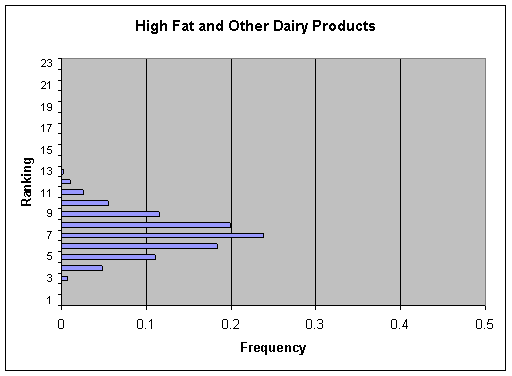
Figure V-20a. Rankings of Total Predicted Listeriosis Cases per Serving for High Fat and Other Dairy Products
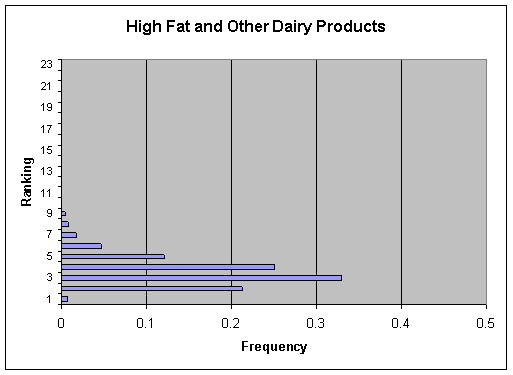
Figure V-20b. Rankings of Total Predicted Listeriosis Cases per Annum for High Fat and Other Dairy Products
Reheated Frankfurters had a low predicted relative risk of causing listeriosis in the United States on a per serving basis and per annum basis. The initial cooking of frankfurters during manufacture is sufficient to eliminate Listeria monocytogenes so contamination is associated with the post-processing recontamination of the product. Reheating the product just prior to consumption would be expected to produce a significant reduction in contamination. There is potential for frankfurters to serve as a source for cross contamination prior to reheating, however, there were no data available upon which this could be modeled in the current risk assessment. The number of annual servings, median amount consumed per serving, contamination frequency, and growth rate were moderate for reheated frankfurters.
In this risk assessment, the risk for frankfurters reheated before consumption was calculated separately from those eaten without reheating. Up to 7% of frankfurters are frozen by the consumer before reheating (AMI, 2001). The model assumed that growth would not occur in these frozen frankfurters. It was also assumed (based on survey data) that between 1 and 10% of the frankfurters are consumed without reheating (i.e., 90 to 99% are reheated). To account for the reduction of levels of Listeria monocytogenes in adequately reheated frankfurters, a thermal inactivation step was included in the risk assessment model. There have been two outbreaks in the United States of listeriosis linked to consumption of frankfurters or microwaved turkey franks (Ryser, 1999a; CDC, 1998a, 1999b; Farber and Peterkin, 1991). These were likely the results of breakdowns in food safety controls within the processing plant. The factor that has the greatest effect on the predicted health impact of frankfurters is the extent of post-retail reheating by the consumer.
Consumption data for the frankfurter category include the meat portion of various types of frankfurters. This excludes the bun, relish, and other condiments. Frankfurters made with chicken, turkey, all beef, and beef-pork products are included. Bologna, which is processed similarly to frankfurters, but has different retail and home handling practices, is included in the Deli Meat food category. The median amount consumed per serving for this category is 57 g (approximately 2 ounces, the typical weight a single frankfurter), and the annual total number of servings is 6.1x109.
There were nine contamination studies with a total of about 3,763 samples for this food category. Six of the studies were conducted in the United States. One of the largest data sets used to develop the exposure rates for this food category was the result of the recent FSIS analyses of product taken soon after manufacture. These results were modified to take into account the likely increase in Listeria monocytogenes levels that would have resulted from storage conditions and times that would have been likely to have occurred between manufacture and purchase. The large size of this data set had a substantial influence on the overall calculated relative risk.
As introduced above, two underlying assumptions used in estimating the relative risk associated with this product are that Listeria monocytogenes was transmitted via the direct consumption of frankfurters, and that reheating of the product just prior to consumption is a generally effective means of eliminating the microorganism. Thus, to a large extent the primary factor controlling the risk is the percentage of individuals that do not adequately reheat the product. Nevertheless, if a substantial portion of frankfurter-associated listeriosis cases were the result of the product cross-contaminating other foods prior to reheating or if certain types of reheating were not fully effective in eliminating the pathogen, this would significantly alter the relative risk associated with the product. In such a case, the relative risk would be more accurately estimated by increasing the percentage of frankfurters consumed without adequate reheating. These possibilities are supported by the results of outbreak investigations where the victims reported reheating the product prior to consumption.
In general, the literature references did not indicate whether the frankfurters were made from beef or poultry meats. The percentage of samples with detectable contamination was a moderate 4.8%. The highest levels of Listeria monocytogenes were less than 100 cfu/g.
Five studies reported growth rates for Listeria monocytogenes in frankfurters, including beef/pork, turkey, and chicken frankfurters. The average growth rate at 5°C was 0.13 logs/day. As with most foods, the maximum growth was related to storage temperature. Based, in part, on a survey sponsored by the American Meat Institute (AMI, 2001), the distribution of home storage times assumed that 91% of the frankfurters were consumed within 9 days and 99% were consumed within 26 days.
The predicted median per serving and per annum relative risk rankings for the Frankfurters (reheated) category were both eleventh for the total United States population. The range for the per serving ranking distribution for Frankfurters is moderately narrow (Figure V-21a) and the range for the per annum is similar and normally distributed (Figure V-21b). This indicates that there was a relatively low degree of uncertainty associated with the predicted relative risk ranking for the Frankfurters (reheated) category.
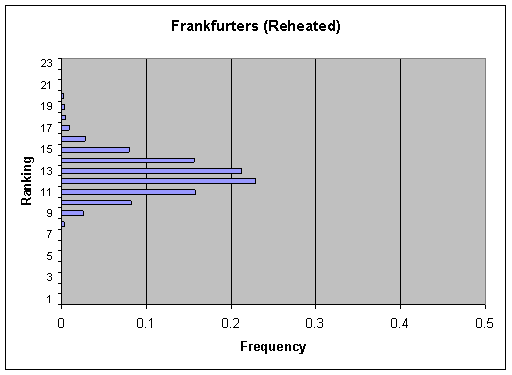
Figure V-21a. Rankings of Total Predicted Listeriosis Cases per Serving for Frankfurters (Reheated)
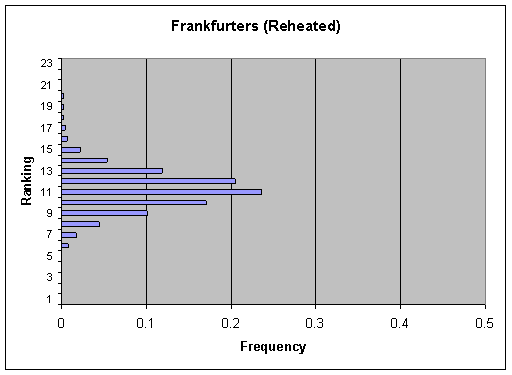
Figure V-21b. Rankings of Total Predicted Listeriosis Cases per Annum for Frankfurters (Reheated)
Frankfurters (not reheated) had a high predicted relative risk of causing listeriosis in the United States on a per serving basis. Comparison of the Frankfurter (reheated) and Frankfurter (not reheated) food categories indicates that post-retail reheating by the consumer significantly reduces contamination levels and the resulting predicted risk to public health.
In this risk assessment the risk for frankfurters reheated before consumption was calculated separately from frankfurters eaten without reheating. In the 2001 draft risk assessment the risk of frankfurters eaten without reheating was determined only on a per serving basis. This category includes the 1 to 10% of frankfurters that are stored in the refrigerator (not frozen) and consumed without reheating (i.e., no thermal inactivation step).
The Frankfurters (not reheated) and the Frankfurter (reheated) categories share the same contamination frequency, contamination levels, growth rates and storage times. See the section above for Frankfurters (reheated) for a discussion of these data. Consumption for the Frankfurter (not reheated) category is a proportion of the total frankfurters. The mean number of annual servings of not reheated frankfurters was 4.7x108 for the total United States population. Without the decrease in Listeria monocytogenes levels from heating, the frequency of contamination at consumption was high with 1.0% of the servings containing 103 to 106 cfu. This is in contrast to the reheated frankfurters, which had a comparative frequency of only 0.5%.
The predicted median per serving risk for Frankfurters (not reheated) category was 6.5x10-8 which corresponds to a relative risk ranking of second for the total United States population. This ranking is based on the assumption that 1% to 10% of frankfurters are consumed without reheating. The predicted median per annum relative risk ranking was fourth, representing a median prediction of 31 cases of listeriosis per year for the total United States population. The range for the per serving and per annum ranking distributions for Frankfurters are narrow (Figures V-22a and V-22b) and concentrated toward the lower ranks (higher risk). This indicates that there was a relatively low degree of uncertainty associated with the predicted relative risk ranking for the Frankfurters (not reheated) category.
Scenario testing: Reduction of the Estimated Consumption of Unreheated Frankfurters
Cooking is a post-retail intervention. Because cooking is an effective method of killing Listeria monocytogenes, the risk from unreheated frankfurters is much greater than from adequately reheated frankfurters. A simulation was run in order to simulate the consequence of an intervention that reduces the number of frankfurters consumed without adequate reheating. Reducing the number of frankfurters consumed without adequate reheating reduced the predicted median number of cases of listeriosis. (For additional details, see Chapter VI 'What-If' Scenarios.)
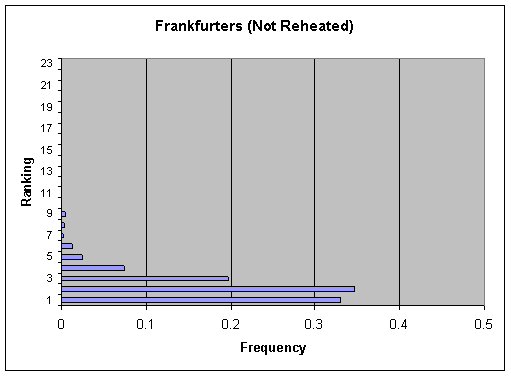
Figure V-22a. Rankings of Total Predicted Listeriosis Cases per Serving for Frankfurters (Not Reheated)
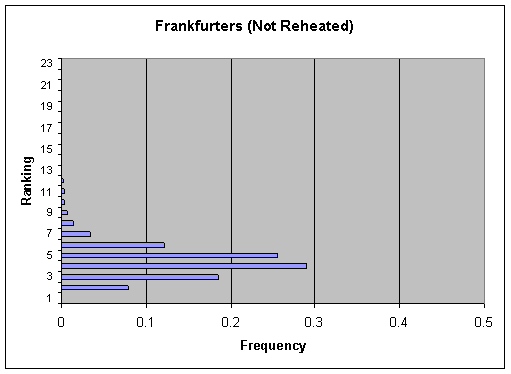
Figure V-22b. Rankings of Total Predicted Listeriosis Cases per Annum for Frankfurters (Not Reheated)
The Dry/Semi-dry Fermented Sausages food category had a low predicted relative risk of causing listeriosis in the United States on a per serving basis. This reflects the fact that this is a food category that does not support growth, despite all other factors except contamination frequency storage time are at a moderate level. This food category included foods such as Lebanon bologna, mortadella, pepperoni, and salami. One outbreak and one sporadic case of listeriosis in the United States have been linked to the consumption of salami (Ryser, 1999a; Farber and Peterkin, 1991).
Consumption data for this category included samples of smoked beef sausage, Lebanon bologna, pepperoni, salami, and Thuringer sausage. The median amount consumed per serving for this category is 46 g (i.e., just over 1.5 ounces), and the total annual number of servings is 1.8x109. Both of these values are considered moderate.
There were 14 contamination studies, including 3 studies from the United States. Three studies provided quantitative data. Products tested included salami, cured chorizo, pepperoni, beef stick, and unspecified fermented, dry and other sausages. Two of the United States studies were from FSIS and included 1208 samples with 32 positives (2.6%). This contamination frequency is lower then the overall frequency for this food category (6.4%) and is a source of uncertainty. The quantitative data are from Europe, with 3 of the 41 positive samples containing 102 to 104 cfu/g.
Inoculated pack studies show Listeria monocytogenes decreases several logs during the manufacture of these meat products and then slowly declines with additional storage. The organism can grow during the early phase of the fermentation or if there has been a fermentation failure. Fermentation failures also have been linked to outbreaks caused by Staphylococcus aureus and Salmonella in products associated with this food category. Four data sets were used to model the rate of decline of Listeria monocytogenes in these foods during storage; the range was 0.0 to -0.036 logs decline/day. The length of storage is long, ranging from 0.5 to 90 days with the most likely 6 to 10 days.
The predicted median per serving relative risk rankings for the Dry/Semi-Dry Fermented Sausages category was fifteenth for the total United States population. The range for the per serving ranking distribution for Dry/Semi-Dry Fermented Sausages is broad (Figure V-23a) and concentrated in the middle ranks (moderate risk). This indicates that there was a high degree of uncertainty associated with the per serving predicted relative risk ranking for Dry/Semi-Dry Fermented Sausages category. The predicted median per annum relative risk ranking was thirteenth for the total United States population. The range of the per annum ranking distribution was broad (FigureV-23b), indicating substantial uncertainty associated with the per annum predicted relative risk ranking. The uncertainty may reflect the variability in the consumption patterns for this food category.
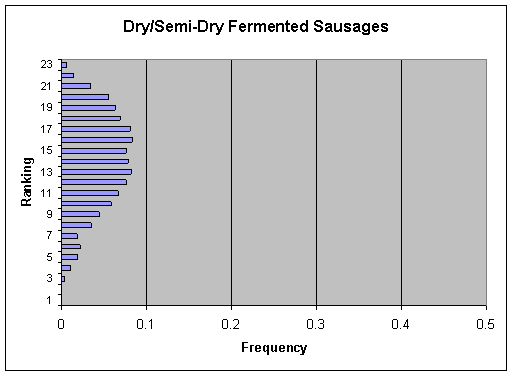
Figure V-23a. Rankings of Total Predicted Listeriosis Cases per Serving for Dry/Semi-Dry Fermented Sausages
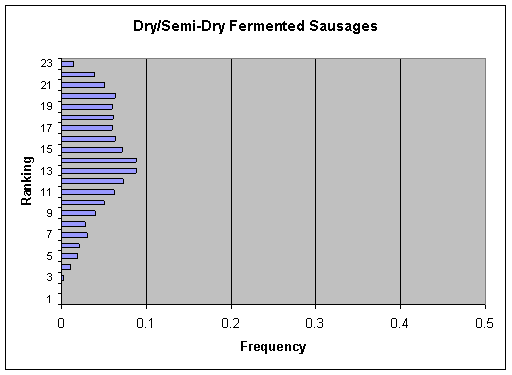
Figure V-23b. Rankings of Total Predicted Listeriosis Cases per Annum for Dry/Semi-Dry Fermented Sausages
Deli Meats had the highest predicted relative risk of causing listeriosis in the United States on both per serving basis and per annum basis. Though this category had a moderate contamination frequency with high contamination levels, there were a high number of servings consumed and a high growth rate, two of the primary factors that drive listeriosis risk in foods. Deli meats have been implicated in two United States outbreaks: a 1998-99 outbreak that was primarily linked to frankfurters but contaminated luncheon meats were also found, and a 2002 outbreak in the Northeastern United States which was linked to poultry products. There have been two outbreaks of listeriosis in France linked to pork tongue in jelly, and an outbreak in Western Australia linked to processed meats (Ryser, 1999a; CDC, 1998a, 1999b).
Consumption data were available for a number of deli meats, such as bologna, ham, turkey, roast beef, chicken, and the meat portion of sandwiches. Consumption databases (and most contamination studies) did not distinguish between pre-packaged and sliced deli products. The median amount consumed per serving for this category is 56 g (i.e., ~ 2 ounces), and the total annual number of servings is estimated to be 2.1x1010.
This category of products encompasses a variety of processes and formulations that can affect contamination and growth. There were 19 contamination studies, including four from the United States. Three studies provided enumeration data. The overall percentage of positive samples from these 19 studies was 1.9%. The 2000 and 2001 surveys conducted by USDA/FSIS observed 2.1% positive samples (395 of 18,506) from collection at manufacturing, however, the 2002 NFPA survey observed a lower frequency of positive samples of only 0.8% from collection of 9,199 samples at the retail level.
The cooking steps that are used to produce Deli Meats are assumed to kill any Listeria monocytogenes present. It is generally assumed that Listeria monocytogenes present in the finished product is the result of recontamination. This is often associated with specific processing steps, such as slicing. Sliced Deli Meats are available in two forms: those that are sliced and then packaged for consumer purchase, and those that are produced in bulk and then sliced in retail stores. It is generally assumed that the latter group of products is more likely to be recontaminated, but would also have a shorter storage time. The NPFA survey showed a prevalence rate of 1.2% for in-store packaged but only 0.4% for manufacturer packaged deli meats (Gombas et al., 2003). Nevertheless, insufficient data were available to allow these two approaches to the marketing of Deli Meats to be distinguished in the risk assessment.
The Deli Meats were differentiated from the Dry/ Semi-dry Fermented Sausages category by higher pH values and water activities that allowed growth. There were nine growth studies conducted on a variety of deli meats including bologna, corned beef, ham, roast beef, poultry loaf, and breaded chicken fillets. Growth rates varied with product composition (e.g., salt, pH) and packaging (e.g., aerobic, vacuum). The average growth rate was 0.28 logs/day at 5°C, a rapid rate of growth. Storage times were relatively long compared with the other food categories. Storage times were based on the survey sponsored by the American Meat Institute (AMI, 2001).
The predicted median cases per serving (77x10-9) and per annum (1,599) risks both correspond to relative risk rankings for the Deli Meats category of first (highest risk) for the total United States population. The ranges for the per serving and per annum ranking distributions for Deli Meats are narrow (Figures V-24a and V-24b). This suggests a low degree of uncertainty associated with the predicted relative risk rankings for this food category. Deli Meats are clearly the highest risk food category of those considered in this risk assessment.
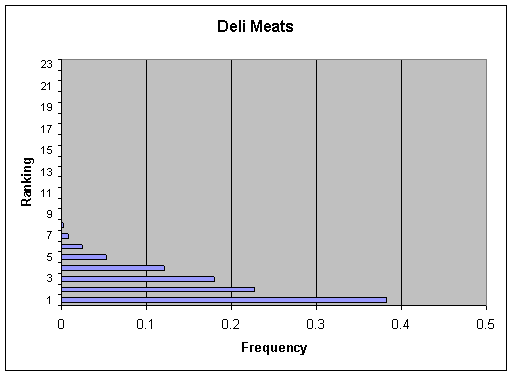
Figure V-24a. Rankings of Total Predicted Listeriosis Cases per Serving for Deli Meats
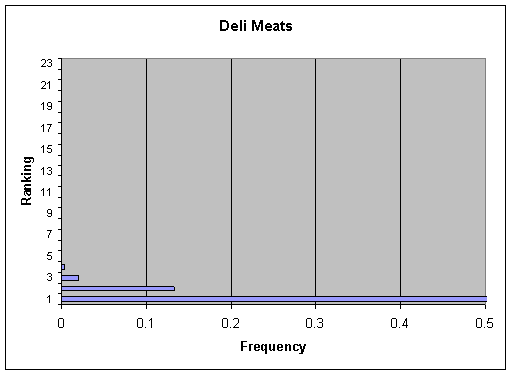
Figure V-24b. Rankings of Total Predicted Listeriosis Cases per Annum for Deli Meats
Foods in the Pâté and Meat Spreads category had a high predicted relative risk of causing listeriosis in the United States on a per serving basis. Foods in this category generally were consumed on an infrequent basis, with moderate serving sizes. The contamination frequency and the growth rates are high and the storage times long. Outbreaks in the U. K., France, and Western Australia have been linked to consumption of pâté (Ryser, 1999a; Goulet et al., 1998).
Contamination data for this category included pâté (e. g., liver pâté) and meat spreads. The percentage of samples with detectable contamination was about 6.5%, which is in the moderate contamination range. Three of the twelve contamination studies were conducted in the United States, including the USDA/FSIS surveys conducted in 2001 and 2002 where 17 of the 721 samples were positive. In total, there were 208 positive enumerated samples (most from the U.K.) with high contamination levels including 3 samples greater than 105 cfu/g and 3 samples greater than 106 cfu/g. The modeled median amount consumed per serving for this category is 57 g (approximately 2 ounces) and the total annual number of servings is 1.2x108.
Pâté and Meat Spreads are known to support growth of Listeria monocytogenes and the two available studies reported high rates of growth (0.14 and 0.36 logs/day). Storage times were long, ranging from 0.5 to 45 days, with the most likely 6 to 10 days. The predicted percentage of servings with 103 to 106 cfu at retail was moderate. Post-retail levels are likely to increase prior to consumption due to a significant predicted post-retail growth.
The predicted median risk per serving for the Pâté and Meat Spreads category was 3.2x10-8 cases of listeriosis per serving which corresponds to a relative risk ranking of third for the total United States population. The range for the per serving ranking distribution for Pâté and Meat Spreads is relatively narrow (Figure V-25a) and concentrated in the lower ranks (higher risk). This indicates that the extent of variability and uncertainty affecting the predicted relative risk ranking for the Pâté and Meat Spreads category is minimal. The predicted median per annum relative risk rankings was sixth (approximately 4 cases of listeriosis per year) for the total United States population. The range of the per annum ranking distribution was normally distributed but slightly broader than for the per serving distribution, indicating increased uncertainty associated with the predicted per annum ranking (Figure V-25b). The broadening of the distribution of the per annum rankings reflects the variability and uncertainty associated with the annual consumption of this food category.
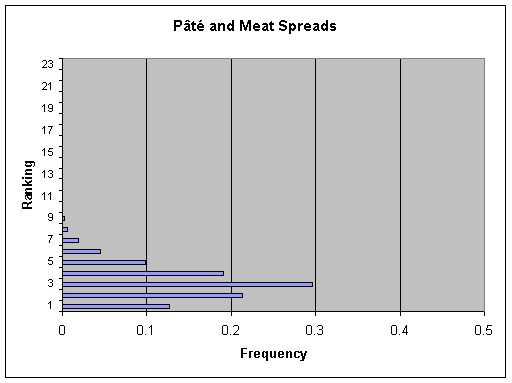
Figure V-25a. Rankings of Total Predicted Listeriosis Cases per Serving for Pâté and Meat Spreads
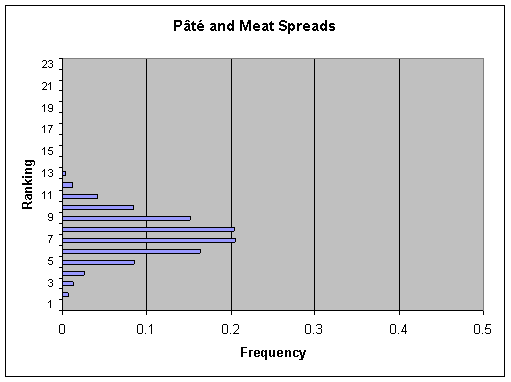
FigureV-25b. Rankings of Total Predicted Listeriosis Cases per Annum for Pâté and Meat Spreads
Foods in the Deli-type Salads category has a low predicted relative risk of causing listeriosis in the United States on a per serving basis. The predicted risk for this food category is much lower than the predication of risk in the 2001 draft risk assessment. Based on public comments and newly available data, there were two major changes to the Deli-type Salad food category for this revised risk assessment. First, the vegetable and fruit salads made with dressing were moved from the Vegetables and Fruits categories to the Deli-type Salads category. Secondly, new growth rate information (Johnson et al., 1993; Eblen, 2002a) indicated that levels of Listeria monocytogenes actually decrease in most types of Deli Salads during storage instead of growing (as assumed in the 2001 risk assessment). The meat, seafood, eggs, and pasta salads from this category have not been linked to outbreaks or sporadic cases of listeriosis, but FDA has monitored recalls of seafood and egg salads because of the presence of Listeria monocytogenes. On the other hand, deli-type salads that are predominately composed of vegetables, have been linked to outbreaks. For example, coleslaw has been linked to an outbreak of listeriosis in Canada, potato salad in the United States and Australia, and sweet corn and rice salad in Italy (Ryser, 1999a).
Although the annual number of servings and median amount consumed are high, the levels of Listeria monocytogenes at retail are low and the storage times are short. Of most importance is that the Listeria monocytogenes has a low growth rate or declines in most of the foods in this category.
This category includes consumption data for a wide variety of meat, seafood, egg, and pasta salads, vegetable and fruit salads with salad dressing, as well as the salad portion of sandwiches. The median amount consumed per serving is 97 g (i.e., about 3.5 ounces, which is considered a high amount) and the total annual number of servings is 1.3x1010.
Changes in Listeria monocytogenes populations were modeled using the newly available data (Johnson et al., 1993; Eblen, 2002a). Decreases in Listeria monocytogenes populations are particularly evident in deli salads made by food processors where sufficient acidity and the addition of preservatives (e.g., sorbate, benzoates) create an inhospitable environment for Listeria monocytogenes. In contrast, Deli-type Salads made fresh in the retail establishment typically were not made with preservatives, and could support growth. FDA research (Eblen, 2002a) showed that retail-made seafood-containing salads permitted growth. It is estimated that 85% of the deli-type salads are manufactured by food processors and do not support growth, and that shrimp and crab salads represent less than 10% of the total deli salad sales (Mitchell, 2001). Storage times were relatively moderate and ranged from 0.5 to 12 days with a most likely range of 3 to 4 days.
Sixteen studies, including six conducted in the United States provided contamination data for this food category. The NFPA (2002) survey, which analyzed 11,236 samples, observed that 3.9% were positive (443 positive samples). The contamination frequency was higher for seafood salads (4.5%) vs. non-seafood deli-type salads (2.4%). Of the positive samples, two contained between 100 and 1000 cfu/g and one contained between 103 and 104 cfu/g. The overall contamination rate for 16 studies in this food category was moderate at 3.8%.
The predicted median per serving relative risk ranking for the Deli-type Salads category was nineteenth for the total United States population. The range for the per serving ranking distribution for Deli Salads was broad (Figure V-26a) but clustered in the higher rankings (i.e., lower risk). The predicted median per annum relative risk rankings was seventeenth for the total United States population. The range for the per annum ranking distribution for Deli-type Salads was slightly wider (Figure V-26b) compared with the per serving ranking distribution. Overall, there was a relatively high degree of uncertainty associated with both the predicted per serving and per annum rankings. This likely reflects that fact that this category includes deli-type salads that do and do not support the growth of Listeria monocytogenes. If additional data become available, uncertainty would likely be reduced if this food category was subdivided.
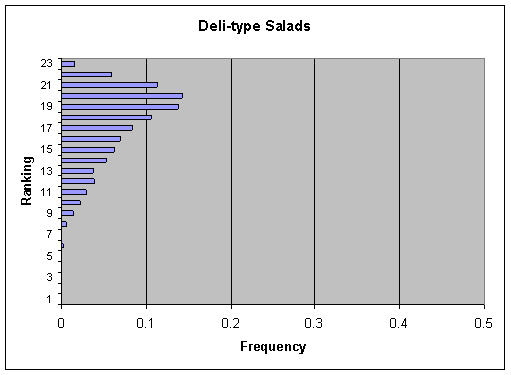
Figure V-26a. Rankings of Total Predicted Listeriosis Cases per Serving for Deli-type Salads
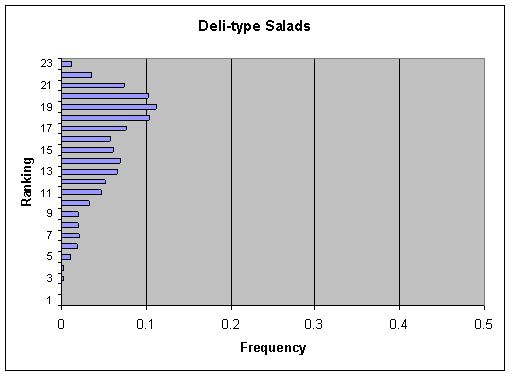
Figure V-26b. Rankings of Total Predicted Listeriosis Cases per Annum for Deli-type Salads
Figure V-1: Components of the Risk Characterization Model
This diagram shows the components of the risk characterization model. The dose at consumption (from the exposure assessment model) is combined with the dose-response function (from the dose-response model) to provide the annual deaths (per dose interval). Including the annual servings consumed (per dose bin) allows the determination of death rate (per annum) and death rate (per serving). The death rates (per annum and per serving) are converted into illness rates (per annum and per serving) by multiplying the intermediate-age population death rate by 11.3; the neonatal death rate by 12.7; and the elderly population death rate by 3.7.